Movie Review By: SSJKamui (Reviewer Forum link)
Year: 2008
Directed by: Yoshiro Nishimura
Written by: Kengo Kaji, Sayako Nakoshi and Yoshihiro Nishimura
IMDB Reference
Degree of Cyberpunk Visuals: High
Correlation to Cyberpunk Themes: Medium
Key Cast Members:
Ruka: Eihi Shiina
Keyman: Itsuji Itao
Tokyo Police Chief: Yukihide Benny
Barabara-Man: Jiji Bû
Bar Independent Diner: Ikuko Sawada
Dog Girl : Cay Izumi
Rating: 5 out of 10
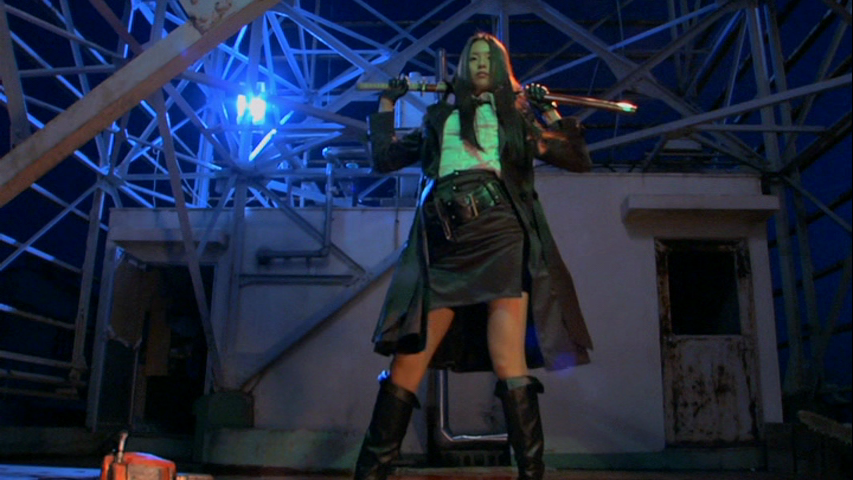
Looking for a good scare this Halloween? Tokyo Gore Police may have what you’re looking for. Be warned: The visuals may be more… “intense” than what most would go for. Let’s say this shit makes your “Friday the 13th, Nightmare on Elm Street, Texas Chainsaw Massacre,” and “Saw” franchises look like Disney productions.
Overview: Tokyo Gore Police is a “Japanese Cyberpunk” splatter movie created by the producers of “The Machine Girl”. The movie is a remake of the independent movie “Anatomia Extinction”. Currently, a prequel short for the movie is in production.
Plot: In the future, the privatized police, under control of the “Tokyo Police Corporation” has developed an extremely brutal, merciless law and order type way of action.
The whole society developed into a sadistic, pervert society with an obsession of violence.
Ruka is the daughter of a policeman who was assassinated in a very brutal way before the police was privatized. Because Ruka saw the assassination of her father, she was traumatized and developed self harming behavior. After the death of her father, she was adopted and raised by the chief officer of the Police Corporation.
Later, an outbreak of a virus causes the infected people to mutate into bizarre monsters. The virus was created by a mad scientist to take revenge on the death of his father by the police. Later, it’s revealed that the father of the mad scientist is actually the murderer of Ruka’s father and the reason for the assassination was actually a conspiracy within the police, where the chief officer of the new Police Corporation has got a key role.
After most mutants were killed by Ruka, the police start a Purge like action where also seemingly randomly civilians get hunted. Among the murdered civilians is also a close friend of Ruka. Because of this and the involvement of her foster father in the assassination of her biological father, Ruka gets mad and starts mutating, too. She fights the policemen and then encounters her foster father. Her father, who started mutating, too and using injections of the virus to get more powerfull starts fighting against his foster daughter.
The story of the film is full of sick moments and extremely brutal scenes. For example, a mutant is a prostitute who eats her customers. There is also a huge amount of psycho-sexual horror, like in the works of H.R.Giger and most other “Japanese Cyberpunk movies”, but some scenes are more funny than scary.
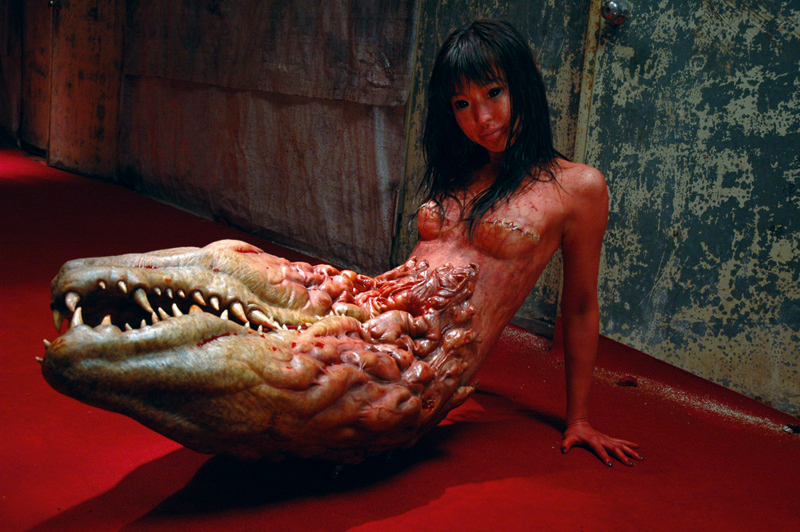
“Vagina dentata” much?
The movie has got a huge amount of black humorous moments. For example, like in the Robocop movies, in the movie, there are certain fake commercial scenes advertising very sick things or speaking funny warnings. For example, knifes for self cutting are advertised in an extremely sick way and there is a television warning that committing Hara-kiri will result in your death. The chief officer of the police also has got a kind of “Cyborg Dog” who looks like a BDSM Costume.
The depiction of the police in the movie is also the clichéd “ultra violent law and order” policemen type which often appear in Cyberpunk works. The most famous ones are Robocop and Judge Dredd.
I agree with the Review on DVD Times.com , the film definitely reminds on Blade Runner, but it mostly lacks the brilliant atmosphere of Blade Runner. Only the driving scene through the streets of Tokyo and the Bar Scene catch a similar, brilliant atmosphere.
The opening scene, where at first, all is peacefull, but suddenly, Rukas father is killed in a very brutal way was one of the best depictions of the concept of “the Real” by the psychologist Jacques Lacan, a kind of traumatic, unexplainable event suddenly appearing which is threatening the function of the mind, I have ever seen.
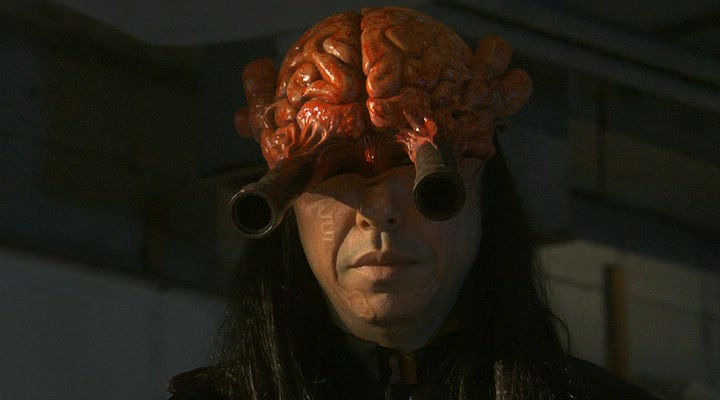
Speaking of unexplainable events suddenly appearing which is threatening the function of the mind…
On most parts, the movie is extremely entertaining, but I don’t understand these “police purge” scenes near the end of the movie and to me, these scenes doesn’t really make sense. The story of the movie isn’t very intellectual, but it’s a good satire on the actions of these populist law and order politicians. The story is also more complex than these Japanese Cyberpunk movies starring Dr.Joseph Mengele like Mad Scientists performing cruel experiments.
Conclusion: Tokyo Gore Police is a truly sick brutal movie like most Japanese cyberpunk films. The story is also not very original and is mostly extremely thin. Nevertheless, it’s still an entertaining satire which can’t be taken seriously. Like all “Japanese Cyberpunk movies”, if you have got problems with violence, you won’t like this movie. Most of the horror scenes aren’t as scary as the horror scenes of the movies Yu On and The Ring, although these movies are less brutal.
Movie Review By: Mr. Roboto
Year: 2008
Directed by: Darren Lynn Bousman
Written by: Darren Smith & Terrance Zdunich
IMDB Reference
Degree of Cyberpunk Visuals: Moderate
Correlation to Cyberpunk Themes: Low
Key Cast Members:
Shilo Wallace: Alexa Vega
Nathan / Repo Man: Anthony Stewart Head
Rotti Largo: Paul Sorvino
Blind Mag: Sarah Brightman
Amber Sweet: Paris Hilton
Luigi Largo: Bill Moseley
Pavi Largo: Nivek Ogre
Graverobber: Terrance Zdunich
Rating: 7 out of 10
Overview: I was hoping to see this movie before seeing Repo Men so I could at least see how close to each other they were. While there are some minor similarities (primarily a megacorp, their organ financing, and the use of repo men) the visuals, story-lines, and this being an opera make the two movies vastly different. While Repo Men’s visuals draws more from Blade Runner, Repo! is definitely goth with frequent scenes involving corpses and/or graveyards.
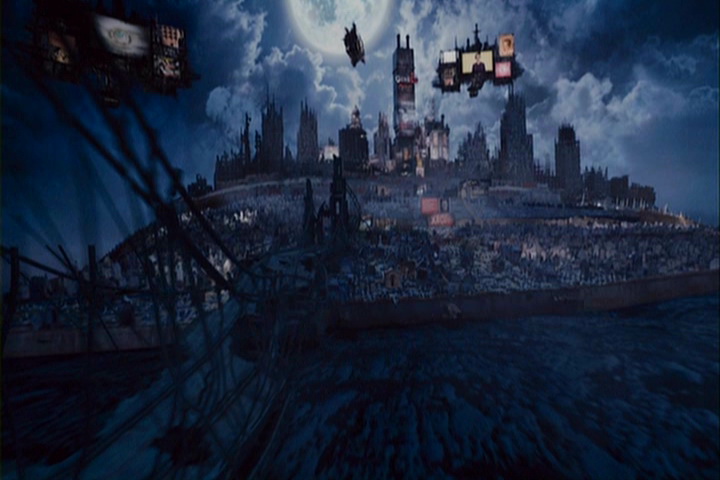
The Story: Geneco becomes the top company when an epidemic of unexplained organ failures sweep the planet. They manage to make organ transplants affordable, but they also manage to get a law passed that allows the organs to be repossessed. Another product Genco makes is Zydrate, a highly addictive pain killer often used by surgery addicts. Geneco is the only legalized source of Zydrate, but a black market exists where grave robbers extract the drug from the brains of corpses.

The current head of Geneco, Rotti Largo (Sorvino), is terminally ill and plans to name his successor at “The Genetic Opera” when popular singer Blind Mag also plans to make her final performance. His three children, the violent Luigi (Mosley), the mask wearing Pavi (Skinny Puppy’s Ogre, FTW), and surgery-and-Zydrate addicted Amber Sweet (Hilton) hope to inherit daddy’s company, but he is disappointed with his kids and has another person in mind: Shilo Wallace.
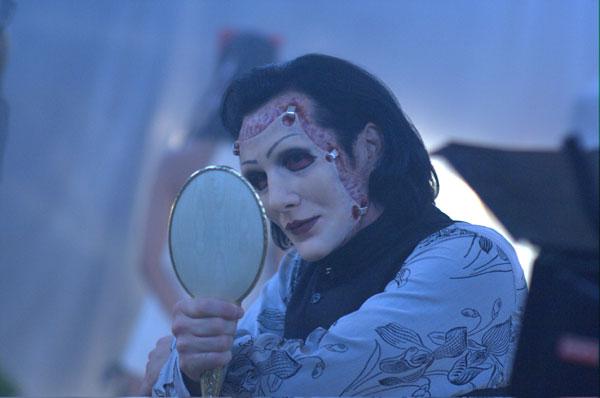
Pavi (Ogre) gets his game face on. Well, he gets someone’s face on.
Shilo (Vega) is the daughter of Nathan (Head), who is not only trying to find a cure for the blood disease that Shilo inherited from her mother, but is also Geneco’s repo man. He keeps her locked in her room, fearing she might die from the disease while he goes out for repossessions. Shilo sneaks out anyway and in her nightly journeys she meets a grave robber (Zdunich) who introduces her to the Zydrate underground and reveals that Blind Mag, Shilo’s favorite singer, is going to lose her eyes because she will no longer be working with Geneco.
A tangled web. With several different story lines going on at once, it may be hard to follow them with all the singing. They may seem unrelated to each other at first, but thanks to comic-styled flashbacks they show how they are connected to Nathan’s dead wife and the upcoming Genetic Opera.
Speaking of the songs, it’s been reported that there were some 65-75 songs made for the film. Not all of them have been used, but do appear on the various soundtracks (memo to self: find the soundtracks.). Most of them are short, only a minute or two, but often involve at least two cast members singing together with different lyrics. This may add to the confusion of following the stories, but not too much to follow if you pay attention.
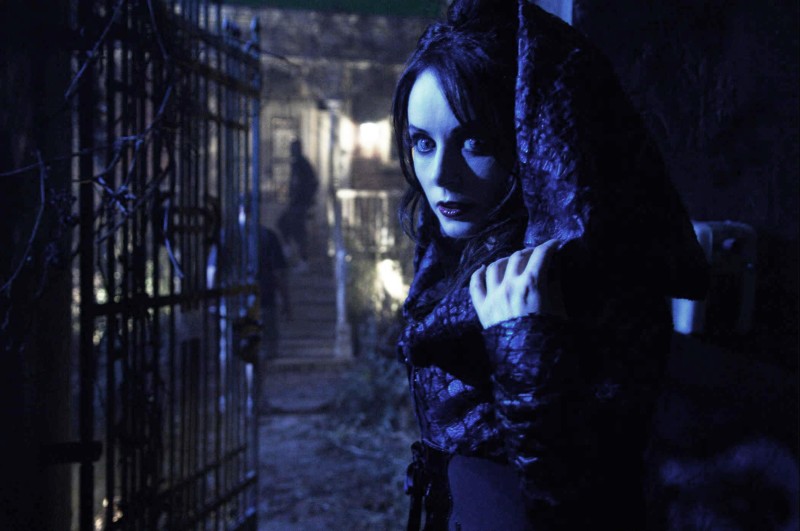
Blade Runner or Count Dracula? The distant city scene above may make one think of Blade Runner’s future Los Angeles, but the closer-in scenes is very much goth inspired. The Wallace house could very well be a haunted house (just needs some more cobwebs) while Shilo frequents a graveyard where her mother’s tomb is (side note: Shilo also collects insects). People are often dressed like they’re going to a funeral or an S&M club. There’s an area called “Sanitarium Square,” where a festival is happening before the Opera, that has brightly lit tents amid the darker streets. Not quite the cyberpunk visuals I was expecting, but does make the dark atmosphere… darker.
Conclusion: To be honest, Repo! wasn’t quite what I expected. It felt more goth than actual cyberpunk, so much so that I’m tempted to tag this as “not cyberpunk.” Then again, with goth style being closely related to cyberpunk lately it can almost be expected. In this case, it helped rather than hurt, as it made the operatic aspects more intense. Repo! is a bit of a bloody mind bender, but certainly worth watching… and listening to.
Movie Review By: SFAM
Year: 2005
Directed by: Clive Cohen
Written by: Clive Cohen
IMDB Reference
Degree of Cyberpunk Visuals: Low
Correlation to Cyberpunk Themes: Low
Rating: 2 out of 10

Overview: So you’re really into big breasted chicks getting gored by robots, ey? If this is the variety of fetish porn you’ve been hankerin for, then Exterminator City is probably an automatic buy decision. One word of caution - you aren’t really getting robots, you’re getting a cheaper version of the old Muppet’s skit, Pigs in Space-style robot puppets. Basically you get shiny plastic robot heads (are these supposed to be metal?) with movable jaws, mounted on dressed clothing racks. A real person wearing gloves is shemping the hand movements, while the lower jaw goes up and down to mimic talking (robots MUST have working jaws, right - I mean who would believe that robots would have speakers embedded in them!). Outside of this small, select market segment of geeks lusting after robot puppets bloodily whacking big breasted chicks off-camera, Exterminator City will probably get a hearty “WTF” from everyone else.

In the one intentionally funny moment of the film, Julie Strain dies by being bludgeoned with an Oscar statue (which occurs off-camera of course, as I don’t think any of these girls even knew they were in this flick until after it was released).
The Story: In the near future (2027), the population is solely comprised of deranged robot puppets and big-breasted chicks who can’t stop rubbing themselves. Worse, these chicks don’t seem to be able to keep clothes on. Robot puppets handle all the work in society, while the bare-breasted chicks hang around their apartments waiting to get randomly gored in some bloody, off-camera moment. While this doesn’t seem like all that successful a society on the face of it, we can only wonder what happened in the previous 20 years that led to this!
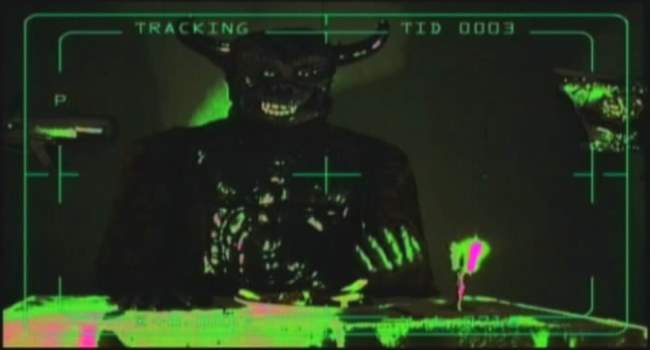
Unfortunately, the poor pesticide robot puppet has nightmares about hell. His response to the rubber demons? He treats them like big breasted chicks and chops them up!
Enter our star - the deranged robot exterminator puppet. For his day job, he’s supposed to be killing the large rubber cockroaches that keep frequenting the bare-breasted chicks’ apartments, but due to a eeeevil after-market robot parts salesman, now he looks at these chicks as bad girls who need his special services. But this is no ordinary deranged robot exterminator puppet. He’s also a master hacker and top micro-electronics expert - he can create his own robot bugs that break into bare-breasted chick apartments! Better yet, he can instantaneously rip out a wall in the exact size of his human-sized robot puppet body, but can also shrink small enough to sneak through the small air ducts that permeate every big-breasted chick abode.
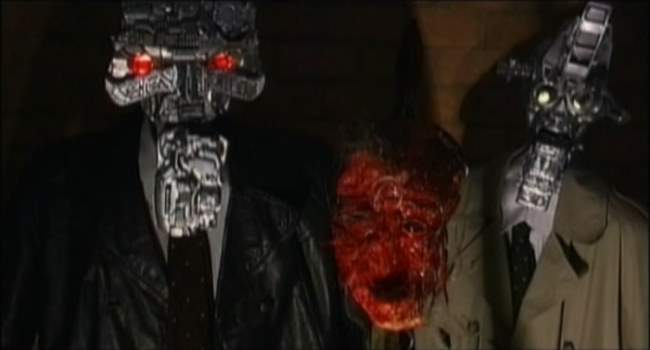
Exterminator City Dialogue Moment:
Police Detective Robot Puppet: “I knew this girl.”
Mad Psychologist Robot Puppet: “You did?”
Police Detective Robot Puppet: “I put her away on three counts of drug violations.”
Mad Psychologist Robot Puppet: “I’d say she’s cured.”
Meanwhile, a bumbling police detective robot puppet is on the case. He may seem useless but he’s sure he’ll catch the bad guy. What’s his strategy for success? He hangs out with a mad psychologist robot puppet (who used to have the pest control robot puppet as a patient) and discusses each gruesome murder after it takes place. Usually they like to mount the most recent dead, bloody and now skinned big-breasted chick on a poll between them (see above) so they can discuss the specifics of her death.
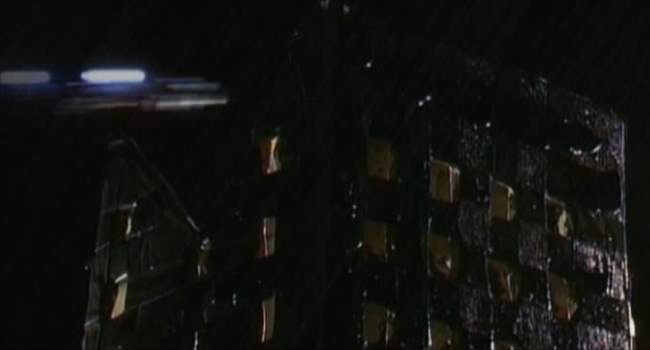
This is the “Blade Runner” police HQ. Yes, in fact it does look like a cardboard box with squares cut out, covered with overlapping strips of spray-painted construction paper. But at least the light stays on, and the zippy things, which are supposed to be the police car, wiz by fast enough that you never get a good look at them.
The Pacing: The pacing in Exterminator City mimics standard porno movie. There is a brief, incoherent beginning scene, followed by a series of action shots that are broken up by brief, incoherent interludes. In this case, robot/bare big-breasted chick slasher porn comprises the action shots. The ending resolution ending scene bookends the front in that its also an incoherent moment that nobody cares about. Between each slasher porn sequence, he interlude shots in Exterminator City always start off with a fast light-car zipping past the cardboard building above followed by an inane puppet dialogue moment. Most often, the dialogue moment involves ridiculous conversations (or sword fights) between the detective robot puppet and the mad psychologist robot puppet, but sometimes we get a “hell” fantasy from the mind of our anti-hero pest control robot puppet. I’m guessing Cohen was trying for a “Space Ghost Coast-to-Coast” type feel for the interludes, but this is just a guess (he failed).

You can tell this scene is still early in the movie because the chick is hawt, can scream well and eventually takes off her top. Later on we get semi-ugly chicks, chicks that can’t scream or worse, ones that won’t disrobe!
Where Did the Big Breasted Chick Footage Come From?: While I know nothing about the making of this movie, I’d bet money that director Clive Cohen has never met any of these chicks. Far more likely, I’m guessing that Clive contracted with some cheesy modeling agency that had pre-made clips of all their “actresses” in a horror-scream type setting. In NONE of the 20+ bare-breasted chick killing scenes do we get any sense that they have a clue what’s going on. Basically, each of them are in some kind of current-day house setting (working out, taking a shower, watching TV, etc.). After a few seconds of relaxation, they look toward the camera and start screaming. The scene then cuts to the deranged robot puppet axing, chopping, chainsawing or bludgeoning through fake skin of some kind. Julie Strain is the only one given more than 40 seconds screen time (she gets like 3-4 minutes). What’s truly funny about this approach is how bad these chicks really are - not only in acting, which is expected, but in screaming. Some are truly horrid.
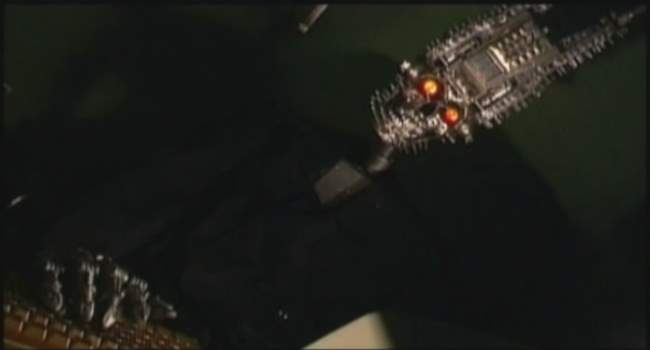
Robots need keyboards to hack into the police database!
Exterminator City Dialogue Moment:
Police Detective Robot Puppet: “He ain’t coming back here no more”
“What makes you so sure?”
Police Detective Robot Puppet:”He had a trace on our trace. He knew we were watching him.”
“So he won’t hack the system again?”
Police Detective Robot Puppet: “He don’t have to. He downloaded all files on route to the kill.”
“So no stopping him now?”
Police Detective Robot Puppet: “You must be sooo proud.”
“No detective. I am not.”
Police Detective Robot Puppet: “I’ll get him”
“How can you know that?”
Police Detective Robot Puppet: “That’s my job, bitch.”
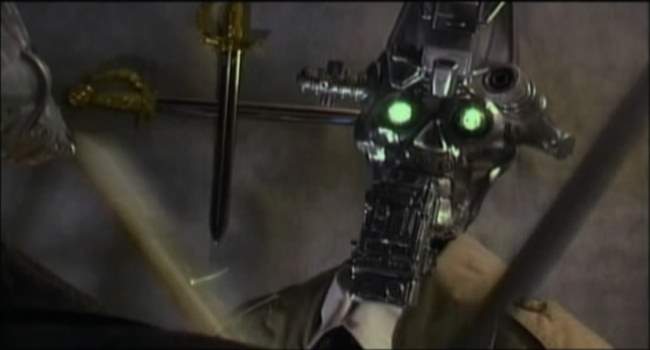
And then a random plastic sword fight breaks out between the police detective and the mad psychologist. Why you ask? Um, don’t ask why…Incidentally, in the close-ups of both puppets, they each have those crossed swords behind them (apparently the walls move quickly to keep the crossed swords in the shot). I think this is to help the viewer recognize that they are having a sword fight.
The Bottom Line: Often when watching a truly horrid flick, you find yourself wondering, “What did this director really want to accomplish?” In this case, its pretty clear - Cohen wanted to make robot slasher porn. Unfortunately he didn’t have a budget, so he settled for robot puppet slasher porn that occurs off-screen. As bad as this “movie” is, I must say that a good number of the big-breasted chicks look really good. And I suppose there’s something to be said for having massive quantities of big breasted chicks to make up for the monstrosity that is this movie. I honestly doubt that anyone besides Cohen actually worked this thing.
But give Cohen some credit: like any good porn movie he knows to keep the better action shots near the beginning, as most will tire of the movie long before the ending comes. As we get to the last third of the movie, the women are either uglier, really awful screamers or won’t take off their clothes. For this organization philosophy, I’m giving Cohen an extra star in my rating (which brings my review to a grand total of 2 stars!). Unfortunately, this approach also means that near the end, we’re stuck with a higher dose horrid dialogue between the detective and psychologist, along with the occasional rubber hell monster. Bottom line, if you do have a hankerin for big bare-breasted robot puppet slasher porn and need to see this, don’t feel guilty in turning it off just after the halfway point.
Movie Review By: SFAM
Year: 2004
Directed by: Hiroki Yamaguchi
Written by: Hiroki Yamaguchi
IMDB Reference
Degree of Cyberpunk Visuals: High
Correlation to Cyberpunk Themes: High
Key Cast Members:
- Luchino: Luchino Fujisaki
- Elevator Operator: Ninalada Mochiduki
- Business Man: Viblio Sawatsukumori
- Housewife: Alamocia Nakaji
- Headphone Guy: Nocosh Utsunomiya
- Serial Rapist (prisoner): Zitacock Obitani
- Bomber (prisonor): Calpico Teranouchi
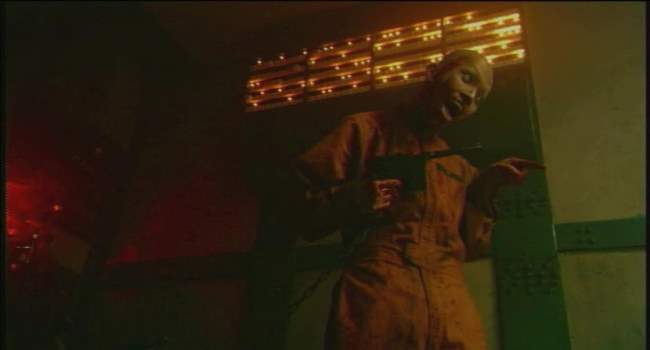
Overview: One thing I love about Indie movies is the opportunity for complete originality. Indie director Hiroki Yamaguchi delivers a strange, but very well made micro-budget movie that is truly unique. From viewing the extras, virtually every part of the set was designed by searching through junkyards for throw-offs. Similar to the Cube, Hellevator: The Bottled Fools largely takes place on a single set. Similar to Brazil, the world of Hellevator is a bizarrely dystopic surveillance society where things just don’t seem to work right. Nobody got paid who worked on this, but you wouldn’t know it from the quality. Hellevator definitely has its own feel.
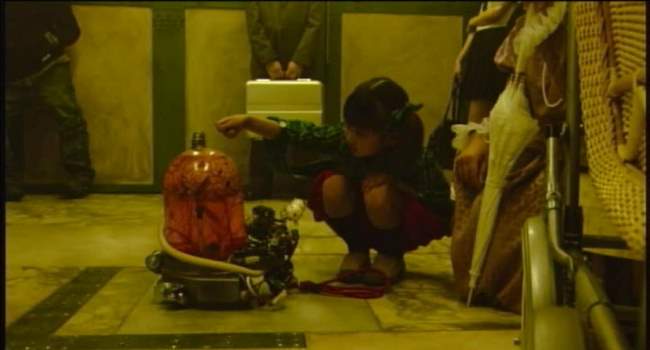
The Setting: Hellevator takes place in a non-specific dystopic near future, where a colony of people have long ago decided to move underground. While some aspects of life clearly involve advanced technologies, there is a strong analog, mechanistic component to society. Now, all life takes place in a very large megalopolis comprised of a set of very large levels and tunnels. Life is fully governed by an omnipresent security force, who have cameras in all key locations. Over 130 levels in all, each has a specific purpose. Some have hospitals or schools, others are power centers, and Level 99 is the prison ward. Because everything is underground, issues related to air quality are at a premium. Smoking is illegal, and merits a death sentence. To get from each level, people use these very large, mechanical elevators.

The Story: The beginning of Hellevator starts off with a television report of a set of explosions on Level 138, which ends up killing over 100 people. The police have pegged a few suspects of causing this crime, both of which ended up stuck on an elevator which malfunctioned during the explosion. Flashback to Luchino (played by Luchino Fujisaki) who is a troubled teen-age girl living on Level 138 who is on her way to school, which is on Level 4. She has a penchant for rebelling against the system and starts her day by illegally purchasing cigarettes from a drug dealer. Unfortunately, she almost gets caught, and ends up leaving her still burning cigarette butt at the power center near a set of flammable fluid containers.
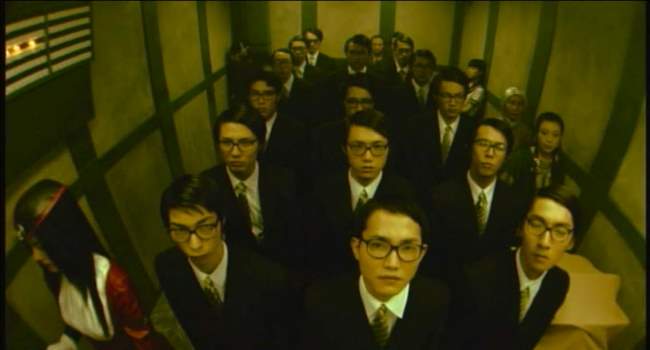
Luchino gets on the elevator to take her to level 4, which is where the rest of the story takes place. On each floor, new people get on while others leave. Eventually when the elevator gets past 110, the elevator operator announces that they have entered the “express mode” – no more stops should occur for a long time. At this point, the elevator is holding the white-gloved elevator operator (Ninalada Mochiduki), a business man (Viblio Sawatsukumori), a woman with a baby carriage (Alamocia Nakaji), a quite guy with headphones (Nocosh Utsunomiya) and Luchino. Unfortunately, the elevator is force-stopped at level 99, the prison level. Two prisoners, one a bomber (Calpico Teranouchi), and the other a serial rapist (played wonderfully by Zitacock Obitani) get on with a very unstable young prison guard. Shortly afterwards, the explosion on Level 138 occurs. This causes the elevator to malfunction, and the small group is now stranded.
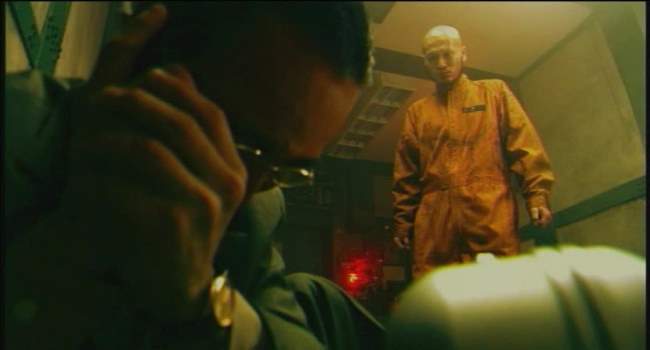
The malfunctioned elevator becomes a powder keg for runaway paranoia. The prison guard starts to lose it, and through a strange sequence of events, causes the prisoners to become free. The rapist quickly beats the guard to a pulp, which ends with a sequence where he takes a bite out of the guard’s neck. From there the prisoners sadistically start to impose their will on the beleaguered elevator participants. The rapist starts to do his thing on the elevator operator and eventually starts kicking Luchino. Luchino starts to have flashbacks of times when her father abused her similarly - Luchino eventually snaps. She picks up the gun and starts to repeatedly shoot the bomber prisoner.

From there, the story devolves into a repetitive set of sequential events which cause various people on the elevator to lose control. Some result in murders while others result in interesting character expositions. Throughout, the mood is high tension paranoia. Eventually, the THX-1138-like guards break the remaining few left alive. The story then connects back to the police detective, who is in the process of interviewing those that survived the elevator trip. The ending, not discussed here, provides a different take on the world which this future takes place.
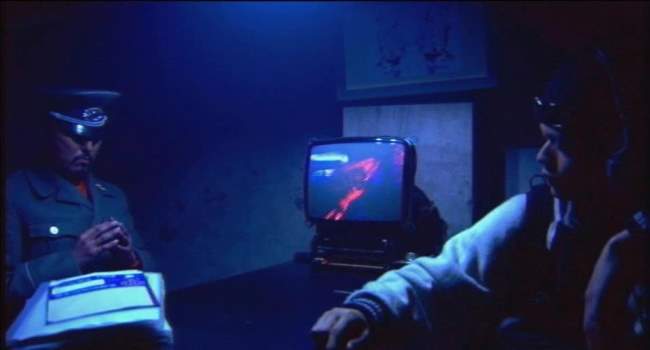
The Acting: The acting in Hellevator is far better than one would expect in a movie where nobody was getting paid. Luchino Fujisaki turns in a solid performance as a person devolving back into psychosis. Zitacock Obitani is terrific as an extremely bizarre serial rapist, and almost makes the movie a must-watch all by himself. The rest of the cast works. The only stand-out lousy performance is turned in by the blond haired prisoner guard, but he doesn’t last long enough to matter.
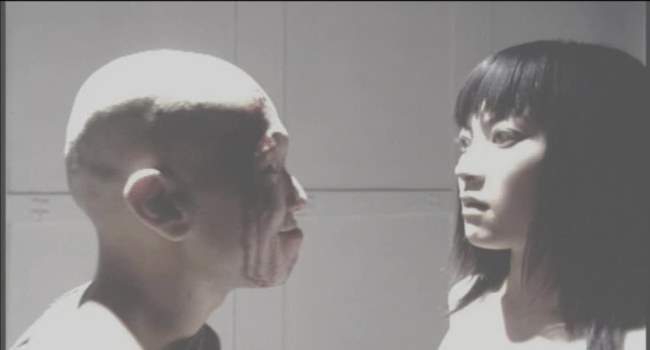
The Cinematography: Hellevator, uses two omnipresent color schemes: within the elevator, everything is dingy yellows and greens. For the police interrogation scenes, everything is dark blue. Yamaguchi makes liberal use of perspective shots, sometimes involving fish-eye lenses, and frequently looking down or up at the participants. In short, Yamaguchi makes the most of a very limited budget and set. He even throws in a Matrix slo-mo shot that was apparently filmed with a single camera.
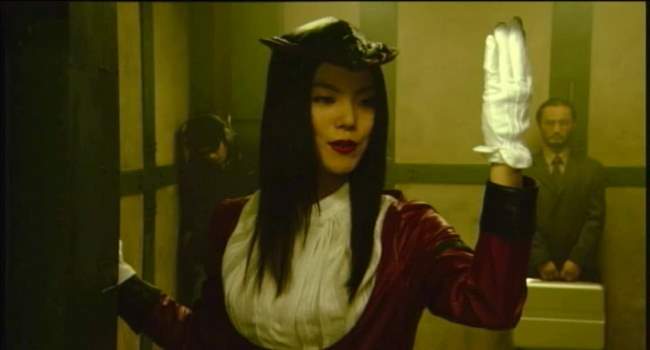
System Service Staff as Robots: In Hellevator, the elevator lady acts completely robotic until the convicts break things. Her overt disposition is of a person who never gets rattled, never intimates a personal connection, and never changes her demeanor regardless of the surroundings. In a sense, she is the perfect employee for the underground megalopolis. Similar to movies like Brazil or 1984, the elevator lady represents the humans as machines metaphor. In this view, we are nothing more than a single redundant part – a cog in a massive machine. For the ideal system employee, individualism has been quashed in favor of ritualized, repeatable routines.
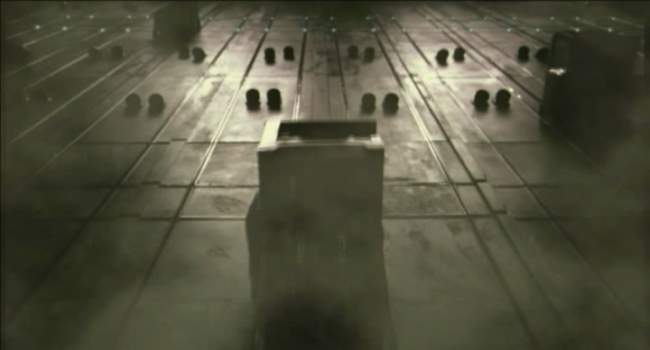
Telepathy: Hellevator does a good job of integrating telepaths into its strange world. The majority of the people are normal, and do not recognize the telepaths. In Hellevator, the Telepaths are able to notice when another uses their sensory perception. What makes Yamaguchi’s view of telepath’s somewhat interesting is he also touches on their ability to see others’ memories. This leads to some interesting flashbacks of others’ experiences on the elevator. More interesting though is the fact that Luchino’s personal psychosis colors her views of the others’ memories. This turns reading thoughts into something far less precise, and in the end makes it more believable.
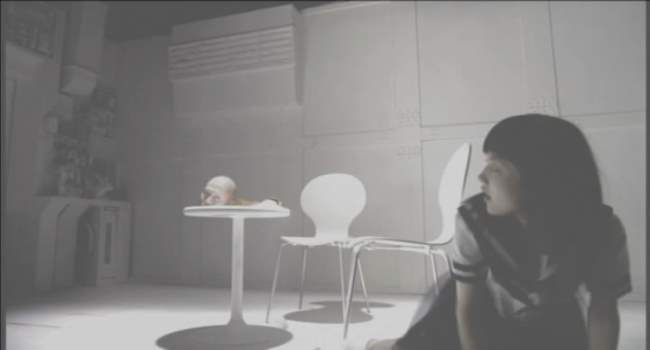
Repression Exposed by Extreme Psychological Pressure: Hellevator explores extreme psychological pressures on a group of already unstable people. Everyone stuck on the elevator is hiding something significant about themselves. The businessman is potentially a bioterrorist; the woman with the crib is hiding groceries instead of a baby, and the quiet guy in the corner is masquerading as a cop. Luchino had been abused by her father to the point that she eventually flipped and killed him. She has since repressed her issues but when placed in a similar circumstance, Luchino responds similarly and goes on to murder one of the convicts. Her perception of reality starts to bear little resemblance to the rest. The robotic elevator woman turns into an emotional basket case. Although this is a fully reasonable reaction to an attempted rape, the contrast shown is with her earlier robotic persona. In fact, everyone, when thrown into this circumstance acts in wholly strange ways.
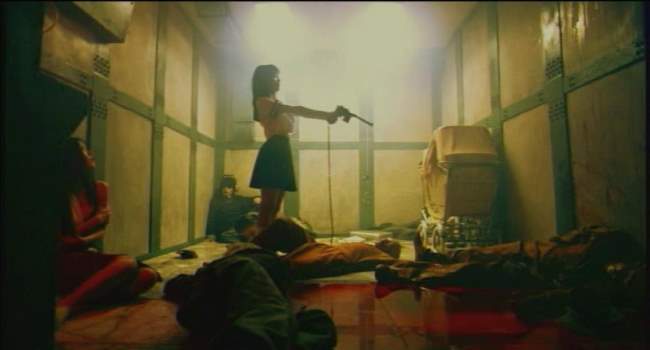
The Bottom Line: If you like Extreme Japanese Cyberpunk movies, Hellevator: The Bottled Fools is well worth a watch. There’s quite a bit of blood and gore, but not when compared to some of the more extreme straight Japanese horrors. The plot is pretty straightforward once the movie gets moving – I would have wished for a bit more interplay between the plot points. Also, there are a number of plot points which were touched on as significant, but were never completed. But overall, the movie is original and interesting. Little throwaways like the child’s pet brain only add to the fun. Yamaguchi and crew really make the most of their set and the overall shoot. This one will stay with you for a few days.
Page 2: More Screencaps –>>
Movie Review By: SFAM
Year: 2006
Directed by: Warren Amerman
Written by: Warren Amerman & Marty Langford
IMDB Reference
Degree of Cyberpunk Visuals: Low
Correlation to Cyberpunk Themes: Medium
Key Cast Members:
- Magdalena: Amy Shelton-White
- Jim: Robert Weingartner
- Arthur: Sanjiban Sellew
- Andrew: David Joseph
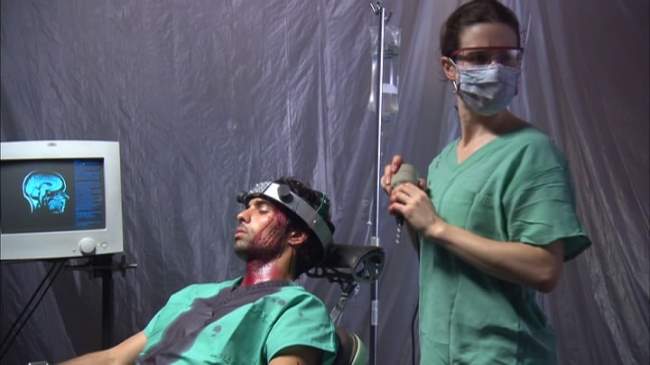
Overview: Rarely do we find low-budget horror movies aspiring to be as intelligent and ambitious as Magdalena’s Brain. Reportedly shot on a shoestring budget of $25 - $30K, Magdalena’s Brain is a professional looking film with some interesting man-machine interface ideas. To limit costs, most of the movie takes place in a single warehouse setting. Unfortunately, this psychological horror is probably a bit too slow for most, and doesn’t have enough gore for the average horror fan (although there are a few good freak-out scenes). But if you do stick with it, you get treated to a fascinating ending twist.
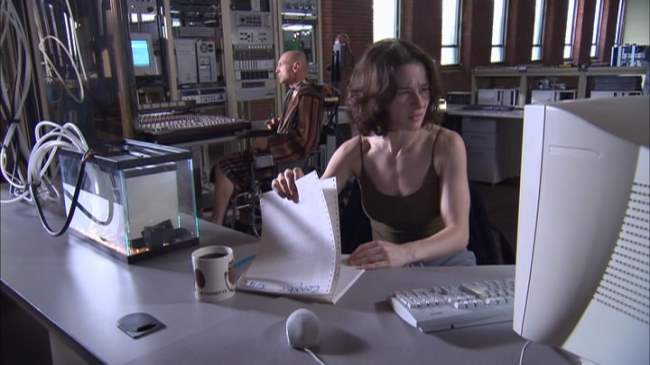
The Story: Former brain surgeon, Magdalena (played wonderfully by Amy Shelton-White) is now a reclusive alcoholic, living in a warehouse, who continually changes out shrinks in the hopes of gaining some semblance of peace. Four years after a tragic accident that left her brilliant husband-scientist, Arthur (Sanjiban Sellew) a quadriplegic and their research in tatters, Magdalena has persevered in the fleeting hopes that things will improve. Magdalena has designed an implant that allows computer-assisted dialogue with her husband. With communication restored, they have been able to continue their research in developing a synthetic brain that processes information 1000 time faster than humans. While the last four years have been slow going, recent advances have shown promise. Currently a blank slate, the organic, crystalline brain structure appears ready memories implanting. Andrew (David Joseph), a love struck former patient of Magdalena (he has inoperable brain cancer), seems to be an obvious test subject, as he will do anything to win over Magdalena.

Magdalena reluctantly takes Arthur’s advice and accepts the help of her creepy brother, Jim (Robert Weingartner), in working out how to kick-start the organic crystalline brain. First, they will download Arthur’s memories into the crystalline structure, then insert the structure into Andrew’s brain, and finally they will remove the tumor. As the story continues, Magdalena becomes more unstable. As everything comes to a head, it appears as if the same issues that led to the tragic accident four years ago might be recurring.

The Pacing: The pacing in Magdalena’s Brain is problematic in places. The first half of the movie crawls at a snail’s pace. In part it’s due to the plot, but the editing decisions certainly contribute. Eventually, it picks up in the second half. The middle of the second half is really where Magdalena’s Brain hits its stride, both in plot and pacing. The movement is brisk and the scenes really tie together well. Unfortunately, the ending action sequence comes across a series of jumbled scenes (again, I’m blaming the editing here). Instead of the frantic chase, they would have been better served having their victim do the slow, bloody crawl, with Magdalena walking after while engaged in her personal struggle. The story would have worked the same either way, but the chosen course asks us to believe that a brain surgeon can’t determine if someone is dead, and that a guy who just had a hole drilled in his brain can run for his life.
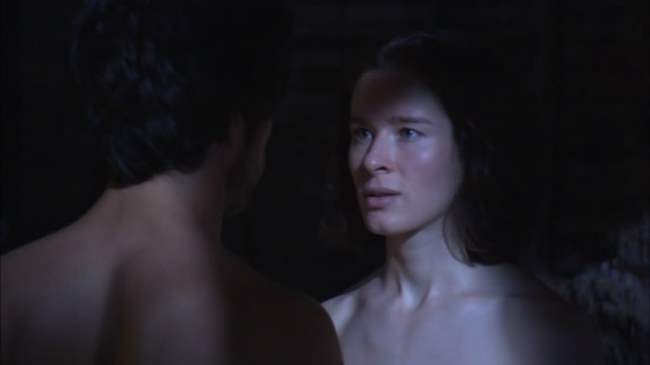
The Acting: If there’s one decision that Director Warren Amerman made that other extremely low budget film projects should consider emulating was hiring a real actor/actress to play the lead role. Even with having only a $25,000 budget, a large chunk of that went toward hiring Lost-Angeles based actress, Amy Shelton-White. Had they not done this, Magdalena’s Brain might have been a disaster. Shelton-White shines to the point that she single-handedly carries the project toward respectability, while adeptly displaying a wide range of talent and emotion. The script is problematic in places, the pacing is too slow, and the rest of the cast are role players at best, but in the end this film still works due to Shelton-White’s performance. Being in virtually every scene, she seems to bring out the best in the rest of the cast. I say this because the rest of the cast suffers when in monologue type situations, but generally hold up well when interacting with Amy. David Joseph (Andrew) in particular looks really shaky in places where he’s basically on his own, but gets lots better when interacting with Shelton-White. I haven’t seen Shelton-White in anything else, but clearly she has the chops to go places. Other the lead, the only performance with mentioning is Robert Weingartner – the “look” he generates as a creepy side-kick really worked well.
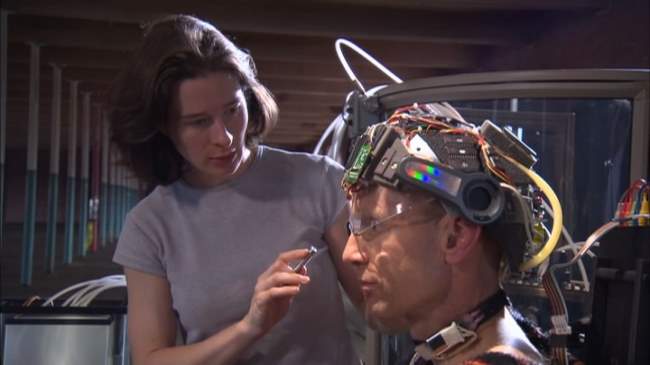
The Cinematography: Often indie films that venture into the Science Fiction genre attempt to make up for low-budget effects with innovative cinematography and lighting. This definitely is the case for Magdalena’s Brain. The use of lighting and shadow always seems to be in the forefront of Amerman’s thinking when composing a shot. Some scenes, such as the bowling scene, really don’t seem to have a place in the film from a story standpoint, but are probably left there due to the wonderful lighting and composition. Throughout the film Amerman is able to take a truly dingy set and come up with some wonderful shots. Also interesting is the lighting and sound choices for the flashbacks, although the horror shots have a cheesy low-budget feel to them. This, along with Shelton-White’s performance is able to help get the viewer through some of the pacing and editing issues.
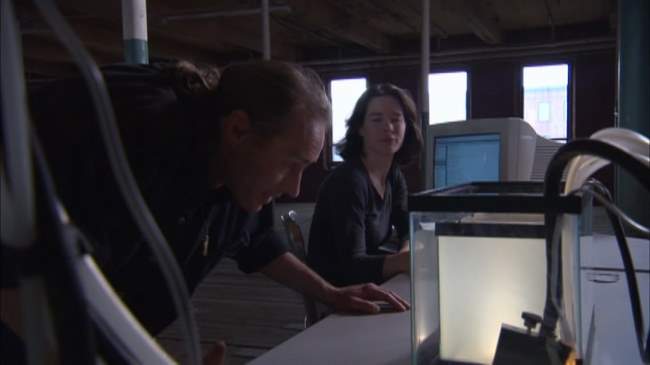
Problems With Organic Brain Design: Magdalena’s Brain uses a different approach toward creating AI. Instead of building a set of programs that mimic some trait of humanity (referred to as the “brute force method), they attempt to replicate the operations of a brain. Through the creation of a “crystalline lattice work in a gel suspension” – the thought is to create a structure that supports the firing of electrodes in a way that allows it to build its own pathways and connections. This part of the techy “mumbo jumbo” was wonderfully thought out, sparking interesting thoughts on how one might go about connecting such a “blank slate” learning structure artificial senses so that it might interact with the outside environment. One can imagine that a structure such as this, once connected to sensory input could grow at an impressive rate
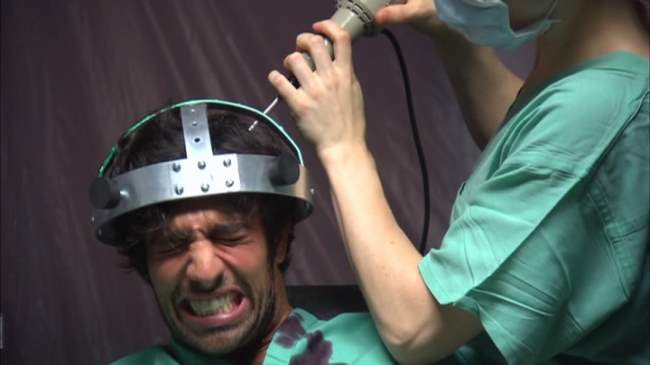
Unfortunately, this is where their science falls apart. They “solve” the blank slate problem by simply “downloading” Arthur’s memories into the crystalline brain. Worse, the brain will apparently make its own pathways using a “first-come, first-served” method of storage. Not only does this approach smack of a “miracle occurs here” scaffold, it also removes most of the innovativeness of the crystalline brain learning structure – as opposed to the pathways being organically grown based on ongoing input from its environment, they simply load a bundle of memories (which are apparently discrete chunks of data) up in sequential fashion. In doing so, they seem to be valuing the mass-storage view of the brain while discounting the interconnectedness of the pathways and concepts. This wouldn’t be too much of a problem accept that their synthetic brain seems based on creating its own connections based on organic growth.
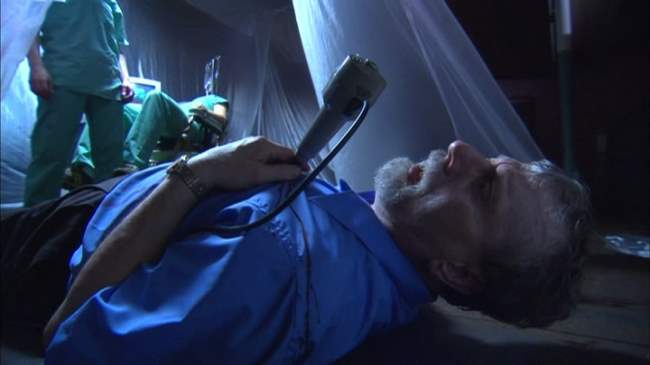
Integration of Synthetic Processing Structures with Human Brains: The most interesting cyberpunk thought in Magdalena’s Brain involves integrating synthetic processing structures with human brains. In the movie, the integrated structure will already have a sentient presence in it (see the downloading memories part above). This is an interesting approach toward building a cyborg with synthetic thinking capabilities, and is a somewhat different approach from say, the Ghost in the Shell method of increasing human capacity. In the GITS Cyborg model, computers are essentially integrated into the human mind, almost as a huge memory bank. The action thinking and decision making largely remain with the human portion of the brain (there are also fully AI processors like the Puppet Master, but they aren’t cyborgs). In the Magdalena’s Brain approach toward cyborgs, one wonders what happens when the two brain structures (synthetic and natural) occupy the same body – will they work in harmony; will one dominate the other; or will a type of schizophrenia emerge? This is all the more interesting when transposed against the psychological struggle Magdalena is undergoing.
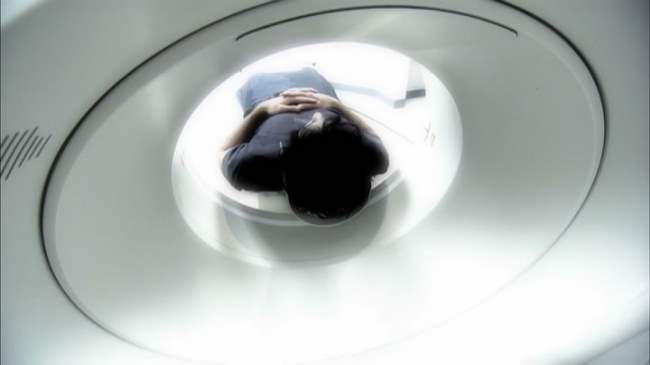
Is Magdalena’s Brain Cyberpunk? Magdalena’s Brain is one of those movies that I think barely makes it into the genre. It takes place in the present, not near future (at least that we can tell), and has no connections to evil corporations. Nor does it have much in the way of cyberpunk visuals. It does however have negative impact of technology down in spades, and an interesting take on the fusion of man and machine. For these reasons, I’ve decided to include it, but just barely.

The Bottom Line: Magdalena’s Brain puts forward a terrific production considering the virtually non-existent budget. It’s very difficult to do a convincing science fiction movie on that type of shoot. I would like discuss the psychological horror aspect of Magdalena’s Brain, but won’t for fear of ruining the ending. The high points are definitely Amy Shelton-White’s performance, and a good number of some well-shot scenes. The audio FX are also worth mentioning, but the score doesn’t always fit. That said, the pacing issues will significantly reduce the potential market for Magdalena’s Brain, as most horror (and many cyberpunk) fans won’t stick with it long enough to get to the fast-paced ending. While it certainly has its problems, Magdalena’s Brain gets a passing grade. There is enough here for indie fans to give it a go, and enough of a jolt at the end that many horror fans will enjoy as well.
Movie Review By: SFAM
Year: 1995
Directed by: Stephen Norrington
Written by: Stephen Norrington
IMDB Reference
Degree of Cyberpunk Visuals: Medium
Correlation to Cyberpunk Themes: Low
Key Cast Members:
Jack Dante: Brad Dourif
Hayden Cale: Ely Pouget
Sam Raimi: John Sharian
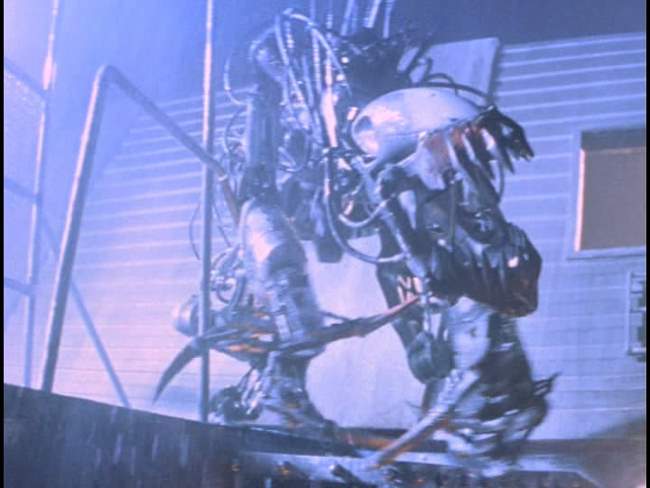
Overview: In yet another of the Alien/Terminator copycat movies, Death Machine is a low-budget, poorly thought out shlock-fest that tries to dazzle you with a largely incoherent in-depth plot and over-the-top acting. While another virtually unknown British Director, Richard Stanley, scored big in a similar but far more original copy-cat movie, Hardware, Stephen Norrington’s Death Match just doesn’t cut it. These types of movies live or die on the overall atmosphere and the quality of the fear the creature engenders. While Hardware excelled on both counts, Death Machine falls woefully short. Worse, Death Machine makes a lame attempt at humour by naming all the bit players with the names from the movies Norrington stole plot bits and visuals from (John Carpenter, Scott Ridley, Weyland, and Yutani)
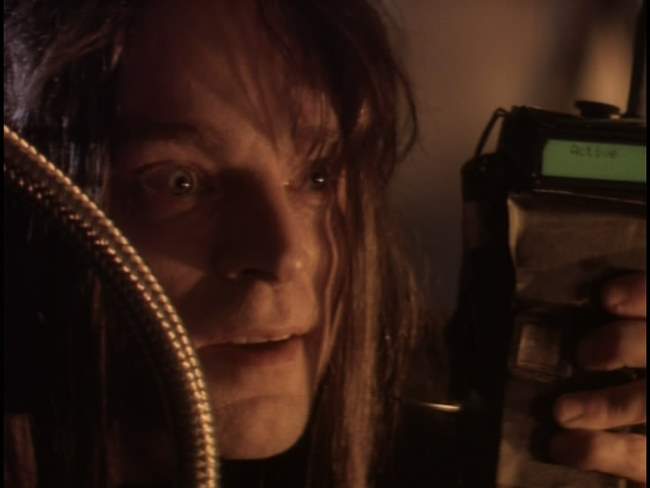
The Story: In the near-future, the evil Chaank Armaments corporation has engaged in a number of shady, classified project that have resulted in dissapearances and potential deaths. Public outcry has gotten out of hand, so for damage control, they bring in an upstanding principled new chief executive named Hayden Cole (Ely Pouget), a hot chick with a porn past to inspire trust and confidence amongst the masses. As she delves into things, it’s clear that the board of directors wants nothing to do with providing full disclosure. Why? Because there is an evil genius mad scientist in the basement named Jack (Brad Dourif), who has the dirt on everyone, and is hard at work at making a death machine to keep everyone in line. Additionally, Jack has created a process for transforming humans into killer-cyborgs. Unfortunately, this process is flawed, and all the cyborgs end up dying.
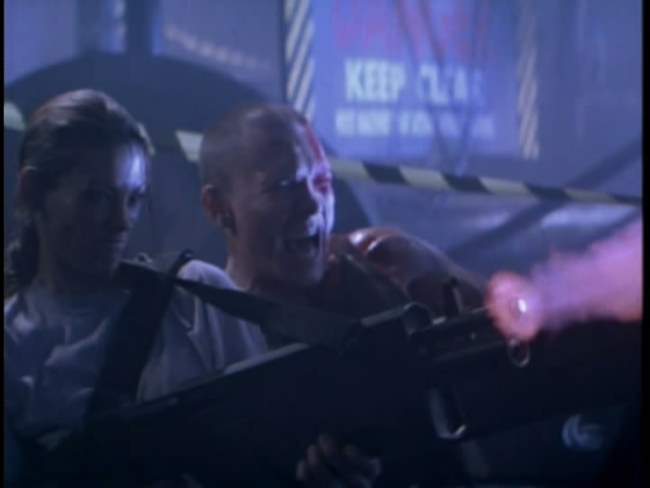
Eventually, the hawt chief executive challenges Jack, and all hell breaks loose. She and a few others become trapped in the building with some would-be amateur freedom fighter cyberpunk types who have invaded the corporation in the hopes of destroying it. Now they are all just trying to escape the robot known as the War Beast. Hayden and Sam Raimi (John Sharian), the leader of the amateur terrorists, spend the rest of the movie trying to evade and eventually kill the War Beast. I could go into more of the plot, but truly, its just not worth it.

The Robot Monster: OK, so we have this really tough robot thing – virtually indestructible. Anyone wanna tell me why this robot has like a hundred rubber tubs hanging out, and nobody who fights it in hand-to-hand combat thinks of grabbing them? More to the point, why don’t the thousands of rounds of bullets affect the tubes? Bottom line, this robot was more silly than scary. In Hardware, the robot was continually shown moving quickly in low-light situations. This allowed Stanley to get away with a low-tech, but very believable robot. Unfortunately, Death Machine doesn’t take this approach – it shows the robot in detail to make sure you see its faults. Color me not impressed.
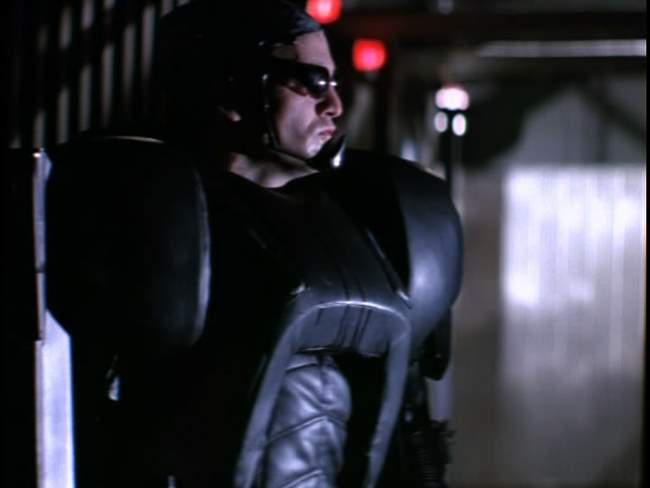
Yes, ladies and gentlemen, you can tell this is a cyborg because he’s wearing sunglasses. Also, he has that really big vinyl and plastic whatever-the-fuck-it-is on - DEFINITELY a sure sign of a cyborg warrior!
Death Machine’s Approach to Cyborgs: In Death Machine, the Chaank Armaments Corporation creates cyborgs by wiping someone’s memory and uploading it with detailed weapon systems training, and simple goals (e.g., protect me, seek out and kill “guy X”). In short, its approach to cyborgs assumes the human mind is synonymous with a hard disk. They even have an instance where a key character’s personality “backed-up” and then wiped from his mind to allow the “warrior personality” to be installed, and then later, they reload the initial personality. Puleeze, Norrington! I’m sure you coulda come up with a marginally believable cyborg warrior rationale. Too bad you didn’t take the time to think of one.
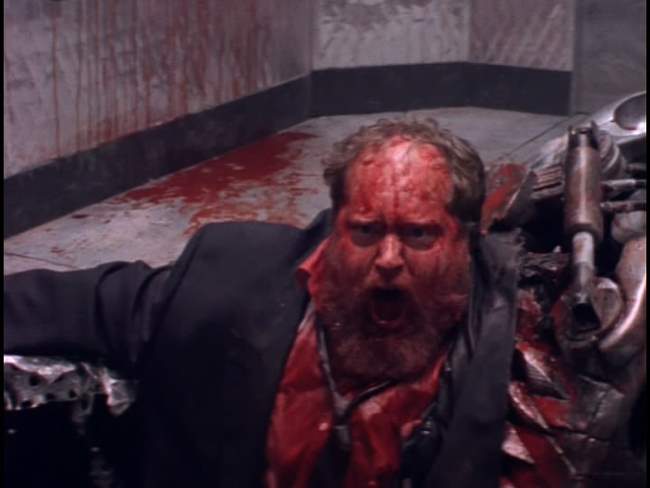
The Bottom Line: Truly, to even have a chance of being watchable, Death Machine would have needed to incorporate a heavy dose of T&A. While Ely Pouget has the looks, this never materializes. This is all the more annoying in that the inclusion of the porn reference flat out portends juicy T&A. Instead, we’re left with a shlock “B” movie, absent of T&A, without the effects, acting, plot or monster to carry the day. Brad Dourif’s character, while mildly amusing is just too over-the-top to stomach, and nobody else other than Pouget even stands out. Even worse, they screw up what should have been a very simple ending (this may be the only original part of the movie - in retrospect, Norrington should have copied this as well), leaving us with a almost complete let down, and no payoff for sticking around for 2 hours. In short, I don’t see much to recommend here.
~See movies similar to this one~
Movie Review By: SFAM
Year: 1997
Directed by: Jean-Pierre Jeunet
Written by: Joss Whedon
IMDB Reference
Degree of Cyberpunk Visuals: Medium
Correlation to Cyberpunk Themes: Medium
Key Cast Members:
Ellen Ripley: Sigourney Weaver
Annalee Call: Winona Ryder
Dr. Jonathan Gediman: Brad Dourif
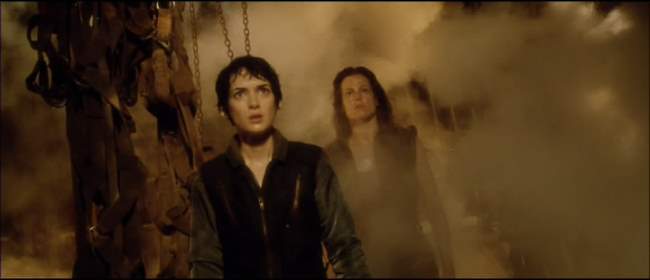
Overview: While Alien 1 and 2 were both stellar movies, the later two sequels definite suffer in comparison. Still, Alien Resurrection provides a significantly different Ripley than is encountered in the first three movies. Ripley is a clone, and an altered one at that. In fact she’s a merging of both the alien and human. With a significantly different approach to visuals and storytelling, Alien Resurrection may not equal the quality of the first two, but certainly can be considered original, which is sometimes a feat in itself for a sequel. The cyberpunk elements, while present, are still sedated, similar to the first Alien (I don’t really consider Alien 2 or 3 to have enough to consider them cyberpunk).
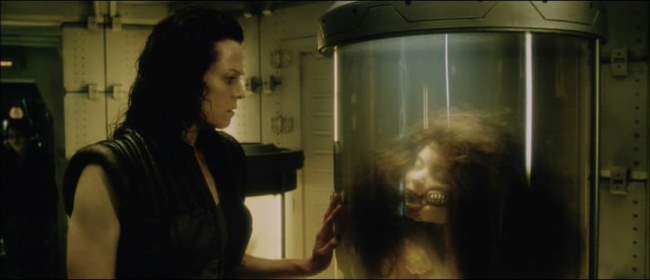
The Story: Two hundred years after her death, Ripley (Sigourney Weaver) has been cloned for the purpose of giving birth to the Alien Queen inside of her at the end of Alien 3. It’s not the corporation this time, instead it’s the good ‘ole government. While it’s never really fully explained how the melding of the two came about, you basically have to “roll” with it if you want to enjoy the movie. In any event, Ripley somehow survives the birth of the Alien, and is kept alive for “study” purposes.
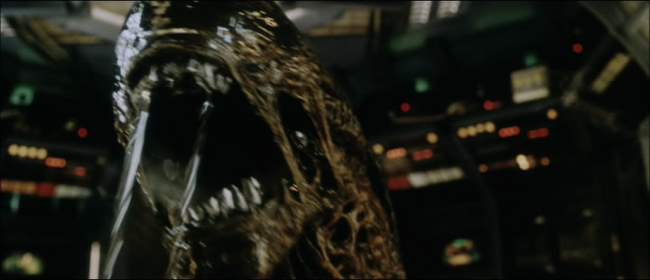
Meanwhile, the Alien Queen that Ripley births requires hosts for her eggs. Enter a group of mercenaries led by Elgyn (Michael Wincott). His group also includes Winona Ryder, Dominique Pinon, Ron Perlman, Gary Dourdan, and Kim Flowers. The mercenaries have captured a ship full of people in suspended animation, and have brought the victims to the military research ship for money and other goodies (including a few days sleep in a regular bed). Things go bad when fanatatical crazed head scientist, Dr. Jonathan Gediman (Brad Dourif) makes the mistake of leaving three of the Alien births in the same cage. Two of the aliens kill the third, who’s acidic innards then create a hole in the floor, thus forming a jail break. From there, its on – aliens are in control and have a field day in eating up the poor humans who can’t escape on time. But unfortunately for the Queen, her DNA has been melded with Ripley’s and her second generation offspring has turned out differently than intended.
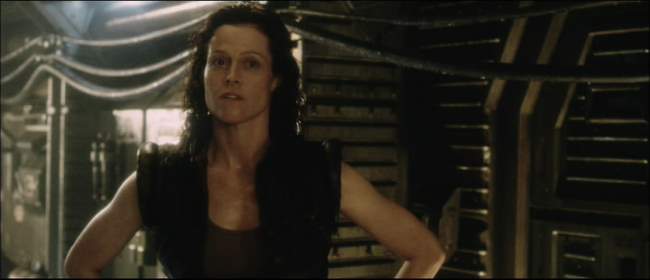
Ripley is Different in Resurrection: In Resurrection, we don’t get the tired, beaten down Ripley from the previous two movies who somehow manages to persevere and survive. Instead, Weaver takes to her genetic change with a gusto that mixes just the right mix of alien swagger, camp, and tender humanity. Most importantly, Weaver doesn’t take herself too seriously here. Ripley’s smirks more than anything else make the impossible set-up bearable. Its almost as if she’s saying, “Yeah, this is Frankenstein 4, but you knew the monster (me) needed to come back from the dead if there was to be a sequel, right? Just roll with it and we’ll be OK.” In short, Weaver almost single-handedly makes this sequel work. Ripley’s one liners (such as, “Who do I have to fuck to get off this ship?”) sometimes even come close to equaling those in Aliens. However, this approach can only go so far - if they ever plan on doing an Alien 5, they’re gonna need to revive Abbot and Costello!
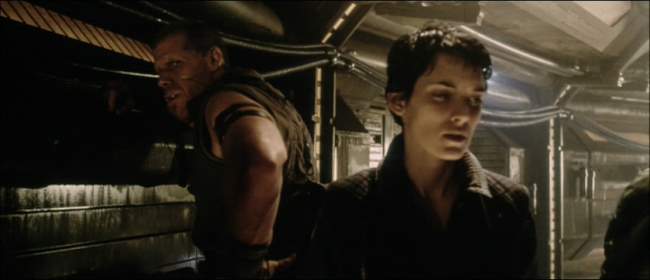
The Rest of the Cast: While Weaver shines, the same cannot be said of the rest of the cast. Some of the member are really hit or miss, while others fail altogether. Winona Ryder’s role was a bit too much for her to pull off. First she had to be a believable mechanic (Kaylee, she’s not!), and then had to be an undercover resistance member and finally had to work as a {SPOILER – highlight to read} second generation android. I don’t know who could have worked all three of these aspects into a coherent whole, but Ryder was not able to pull it off. Although, Ryder does shine in some of the scenes – especially those that are similar to Ripley’s role in the first movie where the Ryder is struggling to maintain sanity when everything is stacked against them. For other examples, Brad Dourif as the crazed scientist is too over the top, and Dan Hadaya as the military commander comes off as a complete imbecile. Two notable standouts are mercenaries Ron Perlman and David St. James – both turn in very solid and interesting performances.
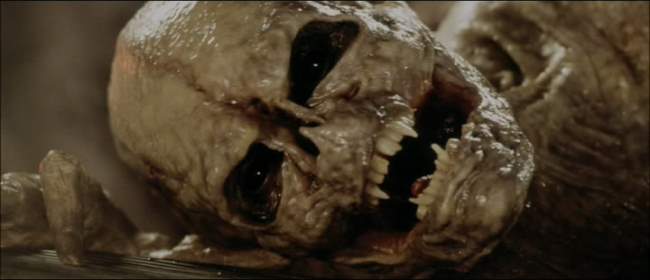
The DNA Mixing: OK, the DNA mixing explanation is just too hokey to work. Joss Whedon deserves some credit for at least not running away from this impossible task – instead he makes it a centerpiece to the story (but it still doesn’t’ work – then again, I don’t think anything would). Basically they needed a way of both recreating Ripley will still keeping her memories intact. Their work-around is to state that Ripley’s and the Alien’s DNAs melded together (I suppose this happened in the lava? Good thing they were able to retrieve it, ey?). OK, fine, but I have a few questions: Aliens are uniquely different from humans but their DNA is so close that its not distinguishable form one another? Or assuming the DNA was melded, how exactly did they know what they were looking at? More to the point, how did they figure out (even with lots of trial and error) to make two completely separate organisms out of the DNA? But even taking the ocean of salt needed to buy that explanation, how is it that an alien organism who grows by eating the material in the lungs is able to read Ripley’s memories and retain them? Again, while this clearly is problematic, you really just have to roll with it if you want to enjoy Resurrection.
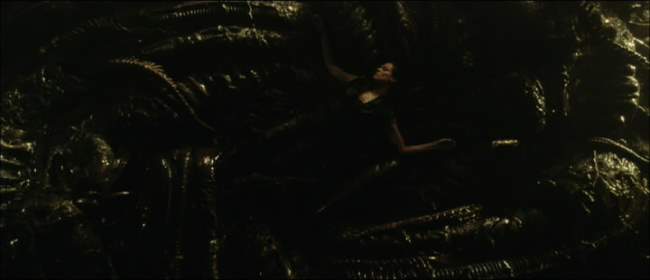
Genetic Manipulation Scare: Probably the scariest aspect of Alien Resurrection is the notion that in the semi-near future, genetics will be advanced enough and so well understood that even your basic crackpot scientists with the right equipment can play Josef Mengele in experimenting with mixing lifeforms to their hearts content. One can imagine a number of variations to this, but the jist of the concern is that its not too far a stretch to imagine that in the near future, less savory governments or corporations may be lured to do various genetic trials of this kind in the pursuit of fame and profit. This concept in Resurrection is as cyberpunk as one can get.
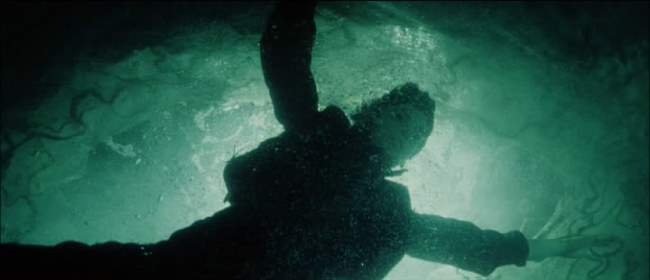
The Android: Unfortunately the back story is glossed over, but in Alien Resurrection, the androids have somehow developed a second generation android, one who is not beholden to human command. Not surprisingly humanity targeted them for termination, which caused the remaining second generation androids to burn out their communications devices and go into hiding. In Alien Resurrection, it’s the android who holds the tenets of humanity most dear. The android is more concerned with the fate of mankind than all the shallow and flawed humans in this movie. The android is even religious. One wishes this aspect of the androids was explored. If they truly feel that they indeed have a purpose for existence, how is this rationalized, and how have they changed the concept of a human deity to accommodate their self-worth?
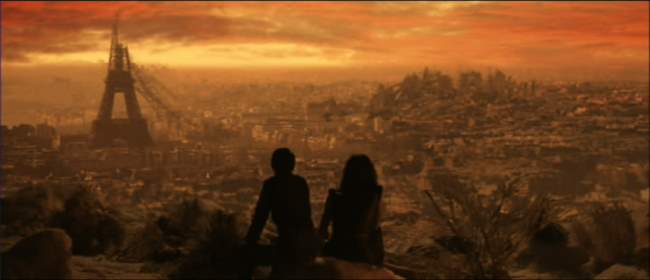
The Visuals: Director Jeunet and visual effects supervisor Pitof deserve credit for creating some wonderful visuals in Alien Resurrection. Resurrection contintually treats us to some wonderfully composed shots – shots that far exceed the qualities of the acting. Even if the plot and acting turn you off, the cinematography, wonderful set pieces, models and creature FX will help keep Alien Resurrection bearable. Like many cyberpunk films, a single color dominates the film – yellow in this case. Yes there are some blacks, but yellow seems to permeate all the key scenes.
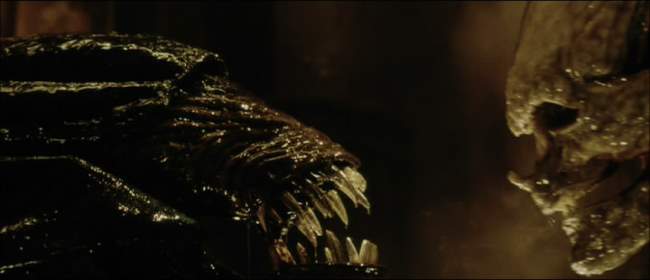
The Bottom Line: Yes, Alien Resurrection has an extremely problematic story within a flawed movie, but it ends up being more fun than it probably deserves. Even though the rest of the cast doesn’t always support her, Sigourney Weaver turns in a terrific performance. This, along with the originality, the wonderful cinematography and FX make Alien Resurrections a step up from Alien 3, and worthy enough to watch. While the cyberpunk elements are subdued, the android along with the genetics and dystopic civilization (destroyed by human wastes and technology) are enough to include it in this site. Alien Resurrection won’t flip your world like the first two did, but its still worth a watch.
~See movies similar to this one~
Movie Review By: SFAM
Year: 1986
Directed by: Shigeru Izumiya
Written by: Shigeru Izumiya
IMDB Reference
Degree of Cyberpunk Visuals: High
Correlation to Cyberpunk Themes: Medium
Key Cast Members:
Lead Researcher (Male): Takichi Inukai
Lead Researcher (Female): Rikako Murakami
Third Researcher: Shigeru Izumiya
Guernica (Android): Mari Natsuki
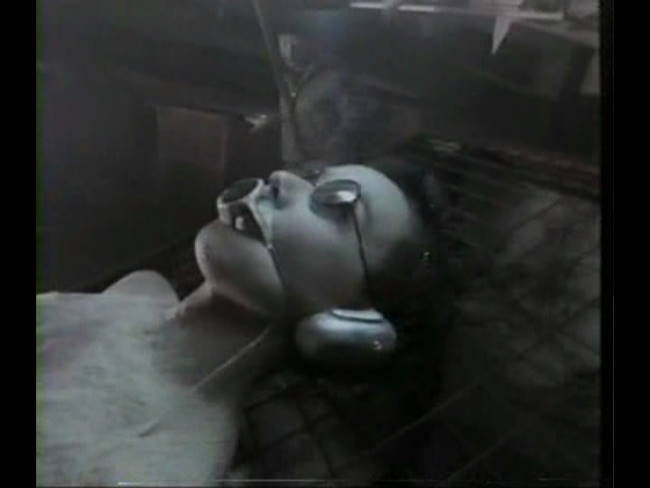
Is there life without death?
Overview: Here I yet again delve into the world of the experimental extreme Japanese Cyberpunk – this time to watch Death Power (Desu pawuda in Japanese), a movie Glam Creature discovered for me. Death Powder is a very low budget, mostly incoherent extreme Japanese Cyberpunk film with some occaisionally very interesting visuals. I probably would have liked this movie more had I obtained either a decent transfer or full subtitles. Unfortunately, the only place I could find this at the time was on LostSilver.com, a site that presses public domain movies to DVD-R format. All the main characters had appropriate subtitles, but the vast amount of mumbling in this film (mumbling usually occurred ultra-bizarre situations) was only subtitled in Chinese. The transfer was so bad that in some scenes the screen appears pixilated.
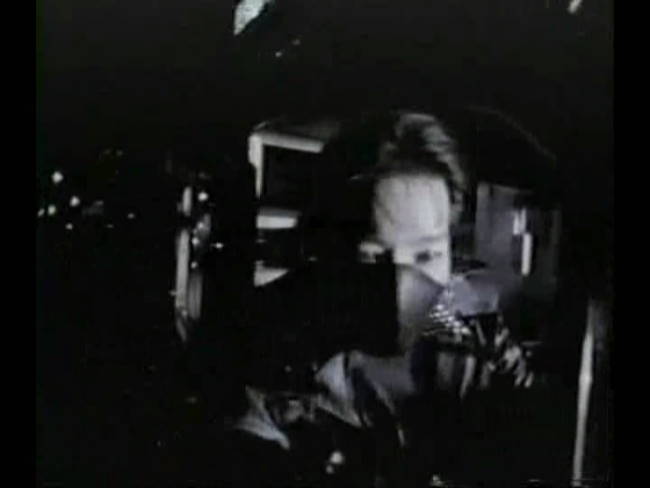
The Story: In the very near future, a group of three researchers has captured a very special android named Guernica (Mari Natsuki), and have brought her to a deserted warehouse, and have tied her to cot, with a protective covering over her mouth. One researcher (Izumiya) is left to guard the Guernica, but appears to be slowly going crazy. Two of the researchers, a guy (Inukai) and a girl (Murakami) apparently have just escaped (presumably from some fallout after capturing Guernica) and are on their way back to the warehouse. Murakami tries calling Izumiya and discovers that something is wrong.

They proceed carefully into the warehouse where they discover that Izumiya has gone crazy and is now trying to kill them. Izumiya makes it to Guernica, who suddenly sits up and blows dust all over Izumiya. From there, the movie turns extremely surreal. Guernica’s body slowly disappears into dust, while Izumiya’s face starts to expand dramatically (in a very low-budget sort of way), while Izumiya rips his hand off and Inukai shoots Izumiya with a futuristic looking gun. Things settle down with Izumiya off hallucinating, while Izumiya has somehow captured and tied Inukai to Guernica’s metal cot. She gets free and beats Izumiya to a pulp.

Sometimes death is the ultimate statement.
Meanwhile, Inukai’s hallucinations have provided him omniscience. Inijai proclaims, “”I understand the secrets of the flesh.” He sees Guernica’s origins and the ongoing struggle with the scar people, who are people who’s flesh is slowly decaying on their bodies. Things get even weirder from there with visuals of massive globs of oozing puss creatures with eyes, an incoherent video montage, a fight with the scar people, and in the end, we find a very bizarre looking monster sitting in a vast setting of emptiness.
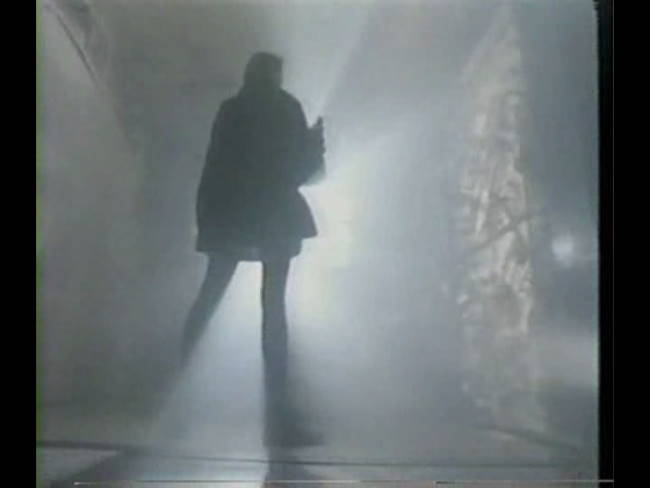
What The Fuck is This Film About??? I fully acknowledge that Death Powder is incoherent enough that attempting to interpret it will potentially lead to nonsensical ambiguity. Unlike others like Tetsuo, which CLEARLY has a point even though many claim are incoherent, this film may not simply hold together well enough to have a clear point. That being said, after two watches, it appears that the death powder is an allegory for technology’s insidious and pervasive destruction of mankind. That Android chick’s name, Guernica, after Picasso’s famous painting, gives us the clue. She is the embodiment of humanity’s destructive tendencies, and like the painting, her ultimate impact is seen with dead, injured, dismembered and torn bodies. That Geurnica is created by a rock star playing an electric guitar indicates that our technology enabled modern culture is ultimately to blame. A bastardized version Christian forbidden fruit analogy also is at play here in that a woman (android) possesses the forbidden knowledge, and humanity tries to access it by capturing her and covering her mouth. The implication is that they hope to possess the knowledge without suffering the consequences.
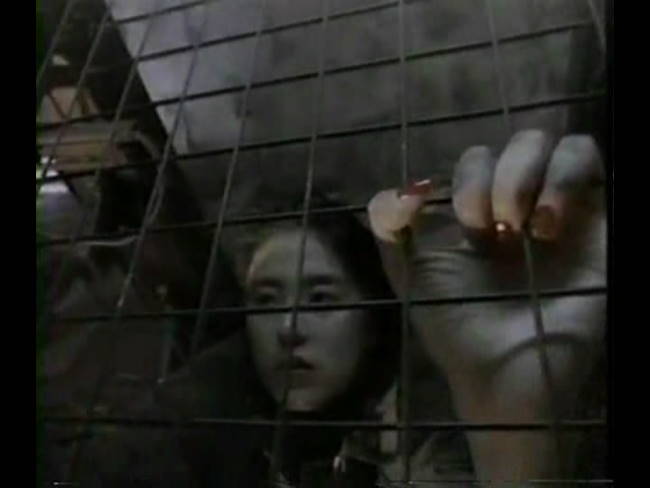
The other aspect that Izumiya seems to explore is the nexus between life and death. Death Powder explores competing ideologies in examining this question. Initially, we are told that “Life without flesh is death.” The researcher, now fully infected and potentially dead, but still thinking (meaning his flesh is dead), responds to this thought with the following:
There is no death without life. There is no Answer to this Madness.
Heaven exists within my body…dead. But Hell…Hell is everywhere!
To which, the Android, Guernica responds, “Is there life without death?” From an android’s perspective, this is probably a VERY interesting line of questioning. If you are able to think, does this not imply you are alive? But if you have no flesh – doesn’t this imply you cannot die? This is of course completely at odds with the original statement. When we include the scar people – a faceless gang of humans losing their flesh – as those espousing that life without flesh is death, we are left with a losing struggle where living humanity (flesh) is supplanted by our technological monstrosities our culture creates. In effect, Izumiya is espousing that humanity slowly dies as our culture is merged with technology. In the end, all that is left is this zombie-like monstrosity that is neither alive or dead, but definitely isn’t human.
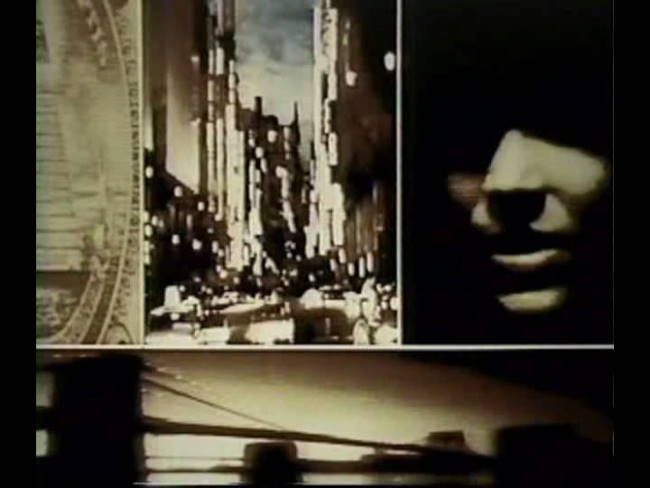
Disconnected Bizarre Video Montage: At about three-fourths through the 62 minute movie, Death Powder breaks into a ten minute plus video montage segment. This occurs after the death powder-enabled android chick states something to the effect that there are far more people to infect, so she must hurry. I’m guessing this is supposed to be Guernica’s Destroy the World tour. This would work except that when its over, we are brought right back to the warehouse, this time to await some workers who are lured into the pit of horrors. In ending it as such, the purpose of the montage seems to disappear. In the end, we are left with the idea that director Shigeru Izumiya had also developed this cool video montage footage, and wanted to include it somewhere. It does look pretty cool though.
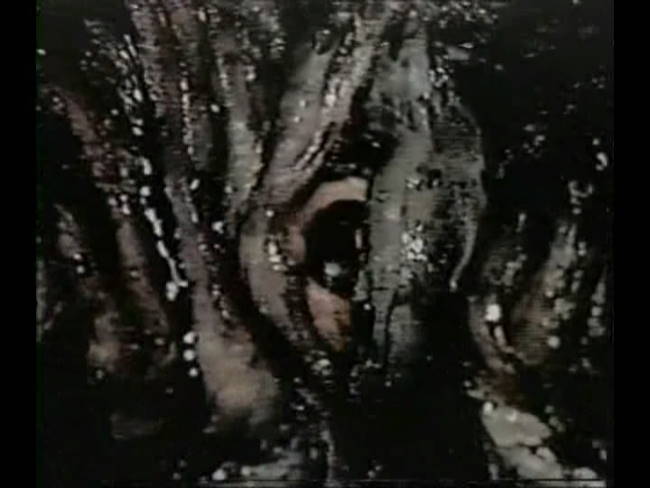
Life without flesh is death.
The Visuals: Like many experimental films, Izumiya literally throws in every kind of camera technique available. We get tons of perspective shots, multiple exposure shots, different overexposed lighting shots, completely strange camera angles (like a sideways up-above running shot), all wrapped up in a myriad of disturbing visuals. Whether we get coherency or not, Death Powder is certainly creative. I really wish I had been able to obtain a better copy of the film, as I’m afraid the color is washed out on Lostsilver’s public domain version (although I don’t know – perhaps this is intentional). This leaves the film with a very washed out, almost (but not quite) black and white look.
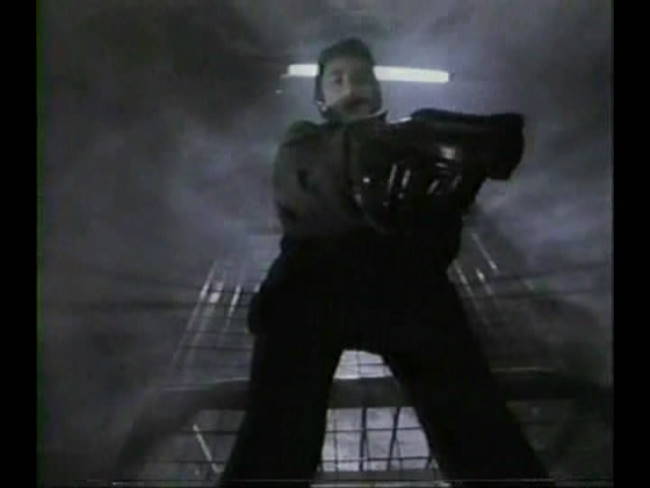
The Sound: Perhaps Death Powder’s best strength is in its sound effects. Izumiya continually barrages the audience with a cornucopia of industrial/techno cyberpunk sounds. We get various low-toned keyboard pieces combined with strange and eerie sounds of all types and textures. If I had to guess, I’d say the majority of the time spent on producing Death Powder was working with the sound track – it’s by far the most polished aspect of the movie. This may not be all that surprising considering Izumiya got his start composing for Japanese Cyberpunk director Sogo Ishii on Crazy Thunder Road.
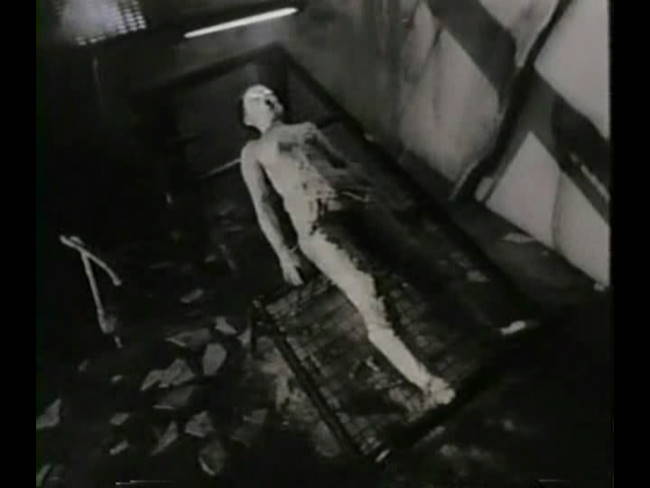
The Bottom Line: I wonder if I’ve become jaded since watching a number of these extreme Japanese Cyberpunk flicks. Many comments about Death Powder indicate that people were blown away by the visuals and have never seen anything like this – some to the point of even having nightmares about it. If this is your first, or perhaps even second experience in delving into extreme Japanese Cyberpunk movies, than perhaps Death Powder comes off much better. However, as much as I love the experimental visuals, this movie clearly could have been put together better. There is a lack of crafting in Death Powder which negatively impacts the movie-watching experience. Still, Death Powder, while incoherent, is at least unique, creative and interesting, so there’s certainly something worth watching here. It’s for this reason that I’m giving it 5 stars instead of 4. I really wish I was able to get a better transfer of this, but even if I had it, I still doubt I’d be giving it more than 5 stars.
~See movies similar to this one~
Movie Review By: SFAM
Year: 1991
Directed by: Shozin Fukui
Written by: Shozin Fukui
IMDB Reference
Degree of Cyberpunk Visuals: High
Correlation to Cyberpunk Themes: Medium
Key Cast Members:
Pinocchio 964: Hage Suzuki
Himiko: Onn Chan
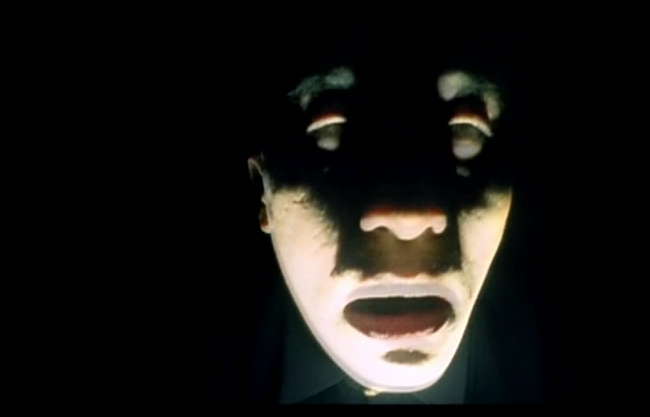
Overview: Back in 1991, Shozin Fukui and crew created a no-budget movie that provided yet another view of Japanese Cyberpunk, one very different from the first Japanese Cyberpunk movie, Tetsuo. In 964 Pinocchio, we don’t get an external merging of man and machine parts – instead, we see the residue of extreme internal struggles – ones that overwhelm the protagonists. The images are very intense, and the pacing is erratic and fast paced. While this movie is uneven and haphazard in places, 964 Pinocchio is definitely a unique experience.

The Story: In this film, 964 Pinocchio (Hage Suzuki) is a strange type of cyborg – someone that used to be human but now has been transformed into a sex slave sold as product. Unfortunately, he no longer “functions” so his owners, a pair of sex-crazed, truly bizarre and sadistic chicks, have thrown him out in the street. Simultaneously, a nurse with a mysterious past, named Himiko (played by Onn Chan), has lost her memory, and she too has been evicted to the streets.
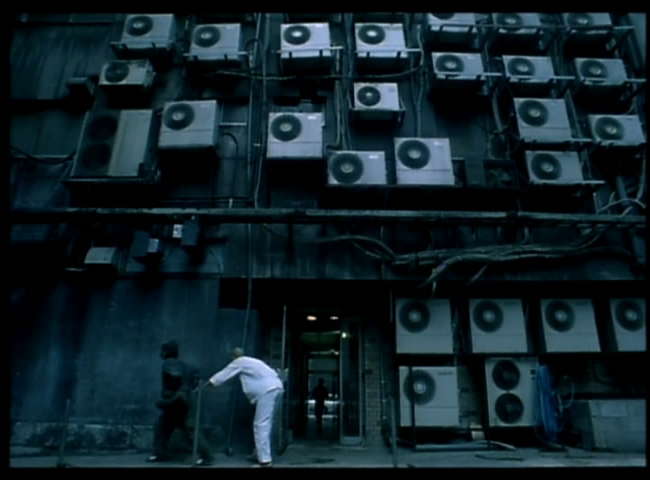
The two outcasts meet up and seem to have a strange attraction to one another. As 964 Pinocchio is essentially a child who seems to have little understanding or awareness of the external world, Himiko takes care of him. She takes him to her living quarters in the basement of a deserted building, and takes him on a food shopping spree where they steal and eat food in the grocery store. Himiko finds out that the corporation that produced Pinocchio is feverishly looking for him, as they are afraid that their illegal process for creating sex slaves will be made public.
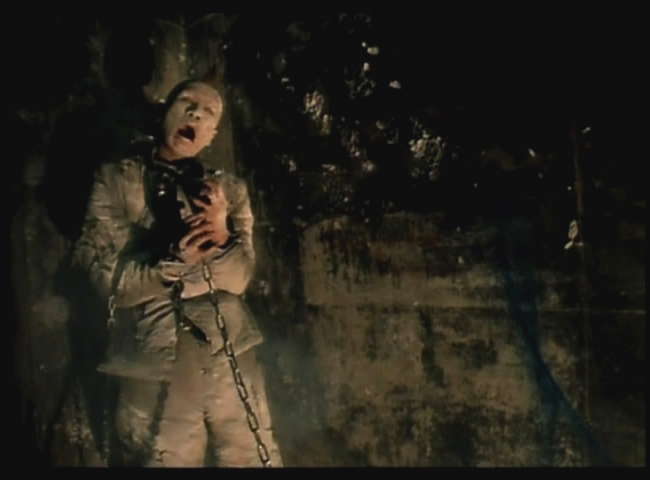
Eventually, 964 Pinocchio starts to gain awareness, and begins to wonder what has happened to him. After becoming frightened and agitated, Himiko calms him down, and then they both realize they have found a “like” soul and then make love (apparently 964 Pinocchio is able to perform when his feelings are re-engaged). Unfortunately, this event unleashes unseen forces inside of 964 Pinocchio – forces that are past the point of control. In short, all hell breaks lose – 964 Pinocchio begins spouting bodily fluids of all kinds and Himiko is thrown against the wall, and finally begins experiencing her own version of the horror. From there, the movie becomes a experiential voyage into the crazed and surreal. The corporation is still after 964 Pinocchio, but they soon discover he is not the same as he once was.
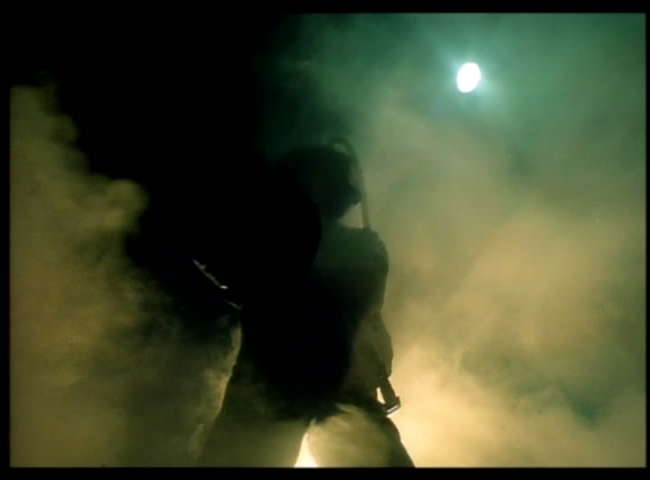
Rubber’s Lover is the Prequel to 964 Pinocchio: Even though it was created 5 years later, Fukia’s Rubber’s Lover is a sequel of sorts to 964 Pinocchio. In this film, we never really understand the process for how Pinocchio was created. Rubber’s Lover gives us a view of this. While the cover for the DVD describes 964 Pinocchio as an android, he’s really not. In fact, he’s virtually all human (although there is a drill to the forehead scene that shows brain matter being removed). If Rubber’s Lover is any guide, he was created by intense sound waves and special chemicals. So at one point he “was” human, but now is “post-human.”
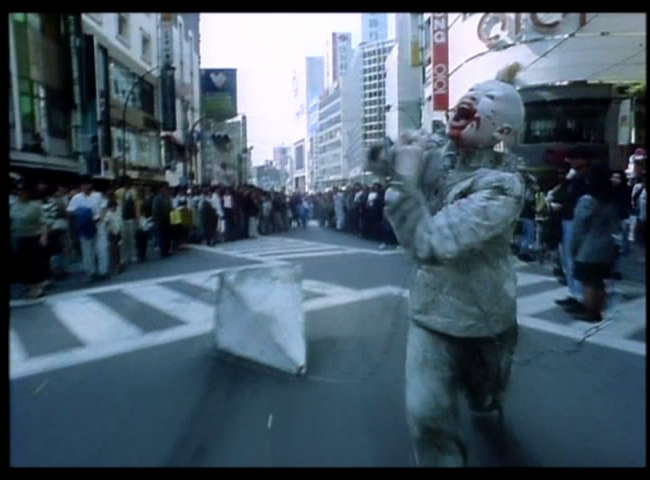
Note to Low Budget Japanese Cyberpunk Film Makers – Use B&W: Because of the low to no budget nature of 964 Pinocchio, the FX are not top quality. While they probably worked better prior to the CG world that we have today, similar to Videodrome, they look very dated in places now. This takes away from the impact of the movie to the point that it just doesn’t really work now unless you put it on a big screen and really crank up the sound. In comparing Tsukamoto’s Tetsuo (a B&W movie) to Tetsuo II: Bodyhammer (a color movie) and Fukui’s Rubber’s Lover (a B&W movie) to 964 Pinocchio, it’s clear that the mood, visuals and ambiance required for Japanese Cyberpunk is FAR better provided by B&W over color. In addition to both Tetsuo and Rubber’s Lover being better movies, they are both FAR more immersive. The low-budget B&W effects don’t detract from the mood, whereas in comparison the color effects look very fake. As an added benefit, shooting in B&W gives the film maker the a critical tool for cyberpunk mood setting: shadows. The use of shadows in a B&W film serve to create a dark, noir feeling which automatically serves up a non-normal mood.
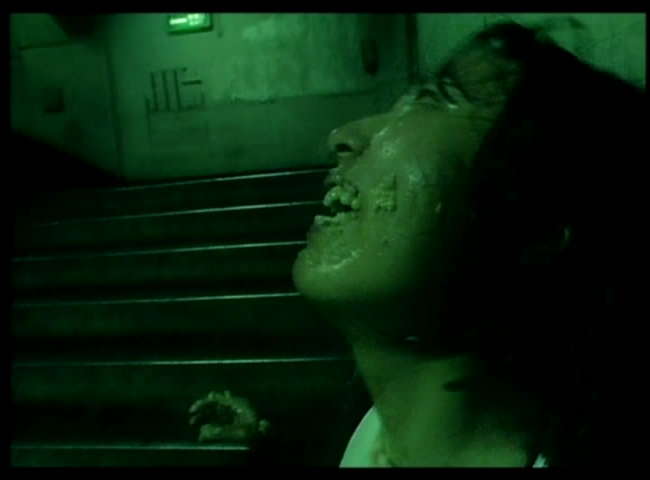
If You Have Vomit Fetish, 964 Pinocchio is For You! Fukui CLEARLY has a vomit fetish, and decides to share it with us in 964 Pinocchio. We’re not talking a wee bit’O vomit coming out - we’re talkin GALLONS worth! Himiko in particular vomits, wipes it on herself, wallows in it, and then eats it all back up! Yummy!
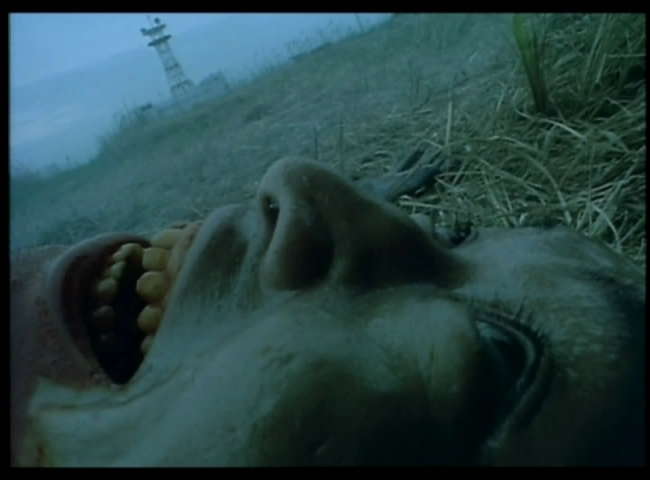
The Bottom Line: 964 Pinocchio is not polished fare, but it does etch out a place in the history of cyberpunk. The story is rather basic, and is really beside the point (many are left confused at the ending – page 2 gives a spoiler understanding if interested). The purpose is to create an immersive mood that details what happens when a dominant power emerges and exceeds human physical capacities. 964 Pinocchio is not for everyone – in fact it’s for a select few. If you aren’t a fan of extreme horror, gruesome imagery, constant screaming, jagged camera work and intense emotions, this movie is probably not for you. If you just want to see a Fukui film, you’re probably better off picking Rubber’s Lover. But if you want an instance of Japanese Cyberpunk in color – the first one in fact – 964 Pinocchio merits a watch.
Page 2: More Intense Screencaps and Spoiler Understanding of the Ending–>
~See movies similar to this one~
Movie Review By: Metatron
Year: 1979
Directed by: Ridley Scott
Written by: Dan O’Bannon & Ronald Shusett
IMDB Reference
Degree of Cyberpunk Visuals: Very High
Correlation to Cyberpunk Themes: Medium
Key Cast Members:
Ripley: Sigourney Weaver
Dallas: Tom Skerrit
Ash: Ian Holm
Kane: John Hurt
Lambert: Veronica Cartwright
Parker: Yaphet Kotto
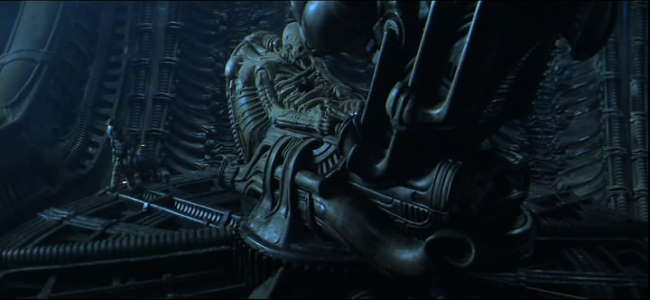
“WHAT’S THE STORY, MOTHER?” Back in 1979, something happened. A momentous event took place, one that would redefine things for years to come, its effects still lingering after all those years. Yet it is neither the none-too-peaceful Soviet meddling in Afghanistan nor the defiant revolt of Iran’s ayatollahs I’m referring to. Something else. A dark vision, a glimpse into the distant void of space. Where no one can hear you scream.
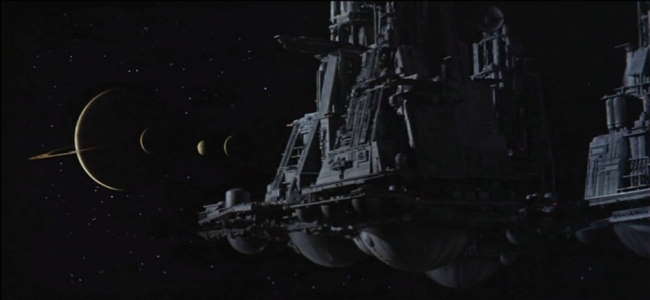
Sure no one could hear ME scream, as it would still be a couple of years before that other great moment in history- the birth of yours truly- but many others sure did when they first saw Ridley Scott’s masterpiece in all its big-screen glory. Must have been one hell of a ride. Another thing I’ve missed then… When I got acquainted with the said macabre flick, it was on a puny twenty-something inch screen and after having seen a multitude of more technologically advanced films. Nevermind. It still blew me away with the force of a 20-megaton nuclear charge. It was something new. An awakening, almost. Don’t ask me how life looked like before Alien. I can’t remember.
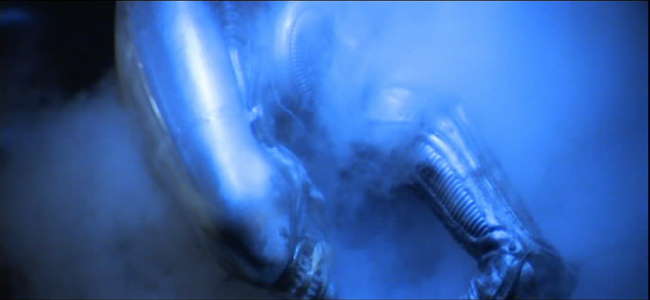
NOT OUR SYSTEM: Okay, so far so good, but there is just one tiny thing. Alien, as the name suggests, is about extraterrestial life. Not of the kind that whooshes past in gaudy flying saucers and abducts cheerleaders, but still very much not of this world. If you think cyberpunk, you obviously think implants, h4×0ring, electric sheep, that sort of thing. Surely a film about a black insect-like monstrosity eviscerating a bunch of interstellar cargo haulers does not fit in here? Well, at the risk of being summarily executed for heresy, I’ll say: yes it does. And, before you get that burning stake ready, I’ll tell you why…
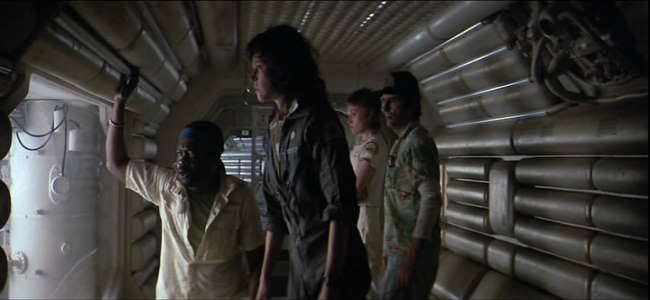
CREW EXPENDABLE: Distant future. USCSS Nostromo, a commercial spacecraft with a gargantuan ore-processing refinery in tow, its 7-man crew in deep hypersleep, encounters an unchartered backyard world from which a mysterious distress signal emanates. Mother, the ships’ computer mainframe, awakens the dreamers- Colonel Ellen T. Ripley among them- to investigate the cryptic transmission, as it is unlikely that its source is anything known to mankind… After landing on the planet’s precambrian surface, the crew discovers a derelict spacecraft… hey, you presumably know all that already anyway! Besides, for those lucky few who are still to live through the cathartic shock that is Alien, I shall try to keep spoilers to a bare minimum. Suffice it to say that they pick SOMETHING up on their unscheduled trip- and this something is just about as friendly to other organic life as H5N1 virus. Only slightly bigger. Needless to say, Colonel Ripley certainly won’t have any good memories from this particular flight…
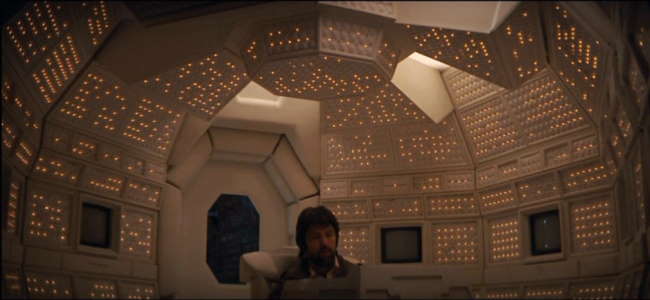
DOES NOT COMPUTE: Now the heretical part. I, regardless of how controversial a view that is, will argue that the original Alien is- you ready for this?- a cyberpunk film. True, it is not PURE cyberpunk in the way the Matrix or Ghost in the Shell are. But then again the vast majority of films reviewed here require some argument as to their cyberpunk credentials. A film does need to have ALL the relevant cyber themes either. Blade Runner and Terminator have no cyberspace, the Matrix has no androids and so forth. Same goes for the visual side. Admittedly, Alien is an uncommon hybrid, a fusion between horror and dark, cyberpunk sci-fi. But this only makes things more interesting.
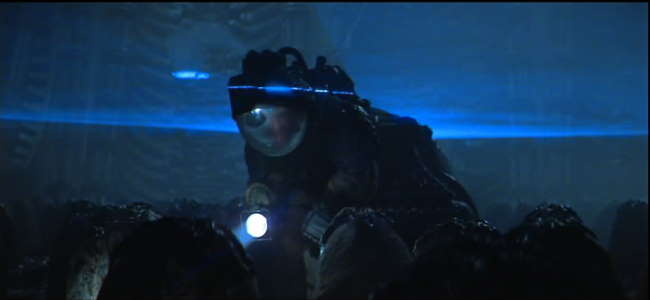
For a start, one needs to mention the existence of a shadowy entity that lurks in the background of the events in Alien (and two of its sequels)- Weyland-Yutani, a dark corporate monolith whose invisible, intangible hand guides many of the events that take place on the Nostromo and beyond. Admittedly, corporate control here is not organized in an oppressive, Orwellian kind of way. Few however would argue that its ruthless actions, removed from any ethical constraints, are any less disturbing. This fictional conglomerate is in fact not far removed from some modern-day corporations that cast aside moral and legal limitations to get what they want. Illegal deals, corruption at the highest level, worker exploitation, illegal drug trials, cover-ups- been watching the news anytime lately? Weyland-Yutani is merely the next step in evolution- a latter-day Wal-Mart, some may say. Not only willing to sacrifice Nostromo’s crew members, it is also quite fine with having its dirty work overseen by a cynical and efficient android, whose cybernetic identity only becomes apparent when a few parts come off…
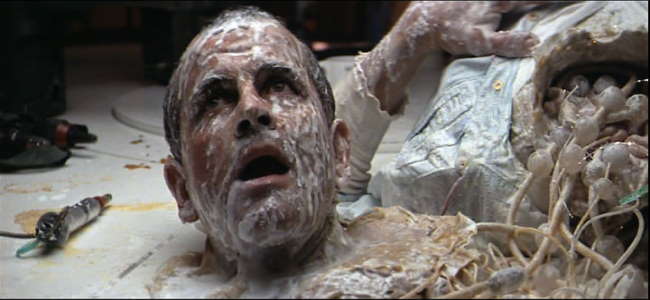
“A GODDAMN ROBOT!”: The inclusion of androids in the Alien series is another overarching cyberpunk theme. The first film does not explore the deeper implications of artificial life as much as the sequels do, but it’s still there. Here, the “artificial person” functions mostly as an extension of Weyland-Yutani’s almost limitless influence, a secretive overseer of affairs who closely follows implanted orders. But the subsequent films will explore this theme further. Rather than merely performing more identity tricks, androids take on a distinct societal role. One might quite correctly remember Bishop and Call, the other synthetics in the series, for their outstandingly vivid humanity, contradicted only by the milky white of their ersatz blood. Yet for all their moral qualities these sentient beings are condemned to an inferior- almost slave-like- role in society. And yet- for now- they accept that role with resignation, tolerating their place in the scheme of things. A programmed limitation? Hardly likely. Given their immensely strong self-awareness, one may imagine how challenging and unfair is it for an entity so humane to accept being treated as nothing more than a piece of property- so much so that Call in Alien Resurrection will at one point voice her defiance and disgust against what she was made to be. By way of comparison, in the first Terminator film the most sophisticated words uttered by our favourite mechanoid executioner are “fuck you, asshole”. See the difference?
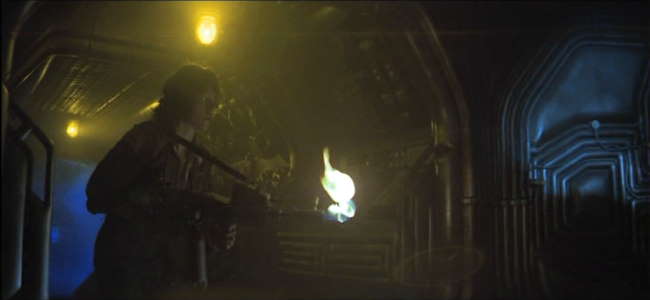
NO FURTHER ENHANCEMENT: The next important bit -the visuals. Powerful, provocative, and atmospheric, they exhibit the studied, gritty realism that has become the calling card of the series. In stark contrast to idealistic visions of the future often seen in other sci-fi films, Alien has gone down a totally different route, one that would later come do be associated with the cyberpunk genre. Case in point- the Nostromo, a far cry from sleek interstellar vessels of old. As it majestically looms into view at the beginning of the film, a mechanical cathedral emerging from the pitch black void, one can see that the film follows an entirely different canon of aesthetics. The ship is monumental, imposing through its sheer mass, intentionally unpretty. Similar approach carries on within, as we explore the craft’s unwelcoming, functional interior of labyrinthine complexity, its dimly lit, grimy corridors filled with snaking wires and exposed machinery. The crew quarters, while cleaner and more organized, seem no less depressing, exhibiting a cold, clinical look reminiscent of vintage computers. Every now and then, the screens will light up with sharply rendered readouts as the mainframes reawaken with eerie electronic chatter. As there was no CGI to fall back against, the only way to create the Nostromo’s vivid interiors was to painstakingly construct the whole set, which gives it a spectacularly tangible quality seldom seen nowadays. And one can almost feel the filmmakers pride, as the camera moves, unhurried, through these cold, industrial catacombs, studying the complex surfaces, celebrating their utilitarian crudity. Along with Blade Runner, this film has defined the core cyberpunk visual reference point for years to come.
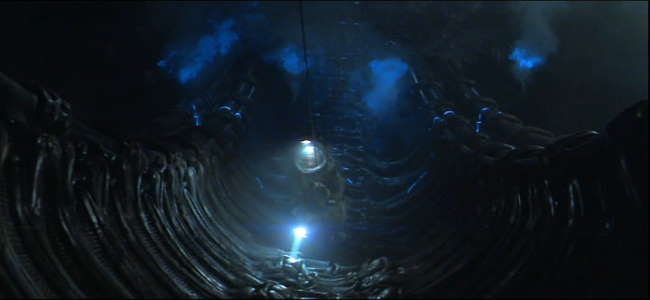
The Nostromo, however, does feel rather cozy next to the primordial desert in which it landed, a dark moonscape filled with surreal forms of bare rock. And it appears positively Arcadian compared to the infamous derelict ship, a bizarre structure, part mechanical, part organic, an otherworldly nightmare. Welcome to the dreamworld of H.R. Giger…
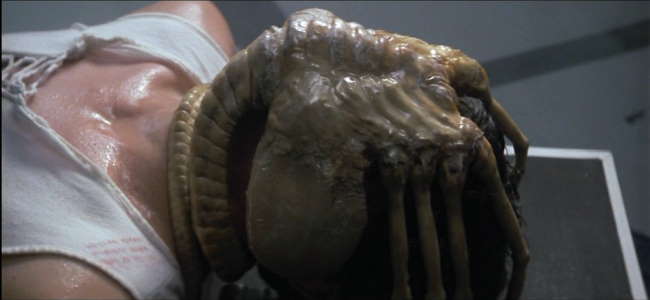
PERFECT ORGANISM: Often imitated and never bettered, Giger is a master of the grotesque. It is his wonderfully twisted mind that has spawned what is probably the greatest creature designs ever. Yet the Xenomorph is only one of Giger’s many dark, disturbing visions- many of which have caused outbreaks of controversy due to their blatant, twisted eroticism. Indeed, much of the Alien’s looks and life cycle can be seen as a perverse sexual metaphor. Yet Giger’s art is first and foremost a study of a peculiar symbiosis between man and machine, an often perverse fusion of the robotic and the organic. Next to his biomechanical mutations, most depiction of cyborg flesh appear staid and conservative. Some theories about the Xenomorph itself in fact suggest that its obscene, insectoid form was not a result of evolution, but deliberate design, the entire species intended for use as the ultimate bioweapon by a mysterious extraterrestrial race to which the forsaken spacecraft belonged. In that respect, it seems to blur the line between biological and artificial life, being something of an organic killing machine. And, it has to be added, a pretty effective one at that.
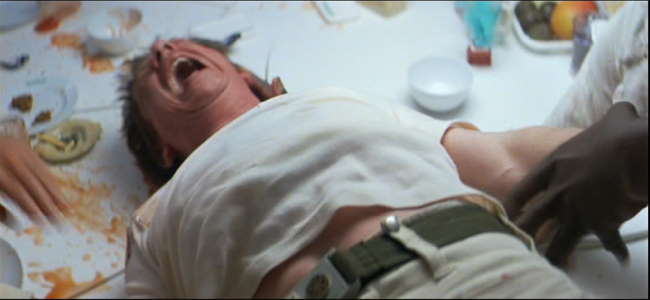
HEAR THEM SCREAM: The sound effects complete the package. From the moody, unmistakable musical score by Jerry Goldsmith to the sonic assault that we are treated to in the final sequences, as self-destruct alerts moan mournfully and explosions fill the air, this is a true masterpiece. The sound effects also have definite cyberpunk traits- the strange bleeps and machine chatter generated by the ship’s electronics are one of the best I’ve ever heard. And the Alien shrieks are almost music to my ears…
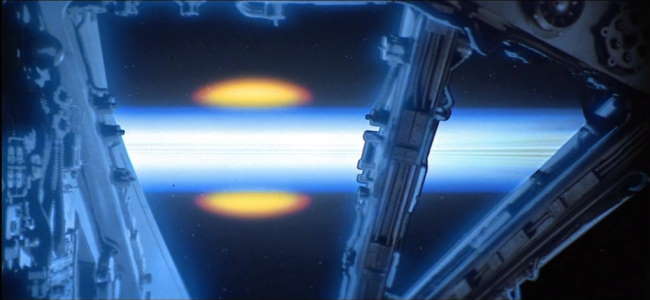
SIGNING OFF: Ripley’s confrontation with the Alien would not, of course, be the last. Three sequels have followed, each surprisingly managing to explore new themes, many of which have strong relations to the cyberpunk movement as well. Rumours of a fifth installment still linger, even though the outstanding flop that is AVP has cooled some of the enthusiasm down, and Weaver, whose evolution from a scared little girl into a seasoned Xenomorph slayer was one of the major aspects of the film, has denied involvement. We shall see. Whatever its future may be, the Alien franchise has often been seen as sitting uneasily among the more obvious cyberpunk films. Being a hybrid, it was bound be frowned upon by the purists. Yet the mere fact that it involved some non-cyber themes made many ignore the fact that it had loads of thematic links to the genre, plus its visual side is arguably closer to the orthodox cyberpunk ideal than Equilibrium, Casshern and Dark City taken together. And that it was made by the very same man who brought us a certain film involving runaway replicants. In fact the series came painfully close to gaining a sort of blessing from William Gibson himself, who has produced the original script for the third Alien film- one that, for some bizarre reason, got rejected. If it succeeded, the perception of the franchise in terms of its cyberpunk credibility might have been very different indeed.
And now if you excuse me, I’m off for a heresy trial…
More Alien Screencaps on Page 2–>>
~See movies similar to this one~
|
























































































